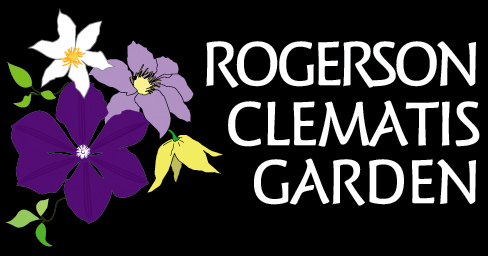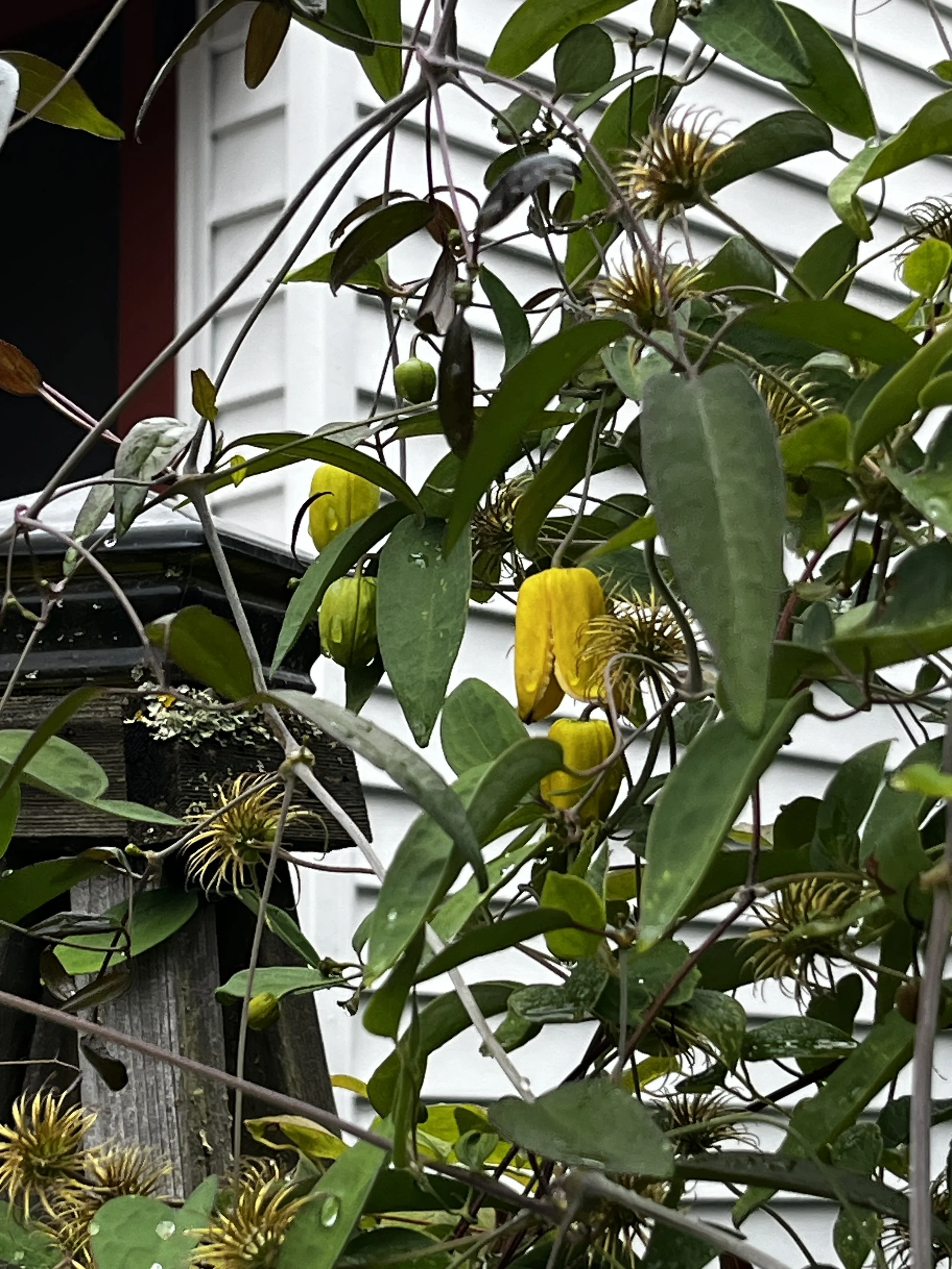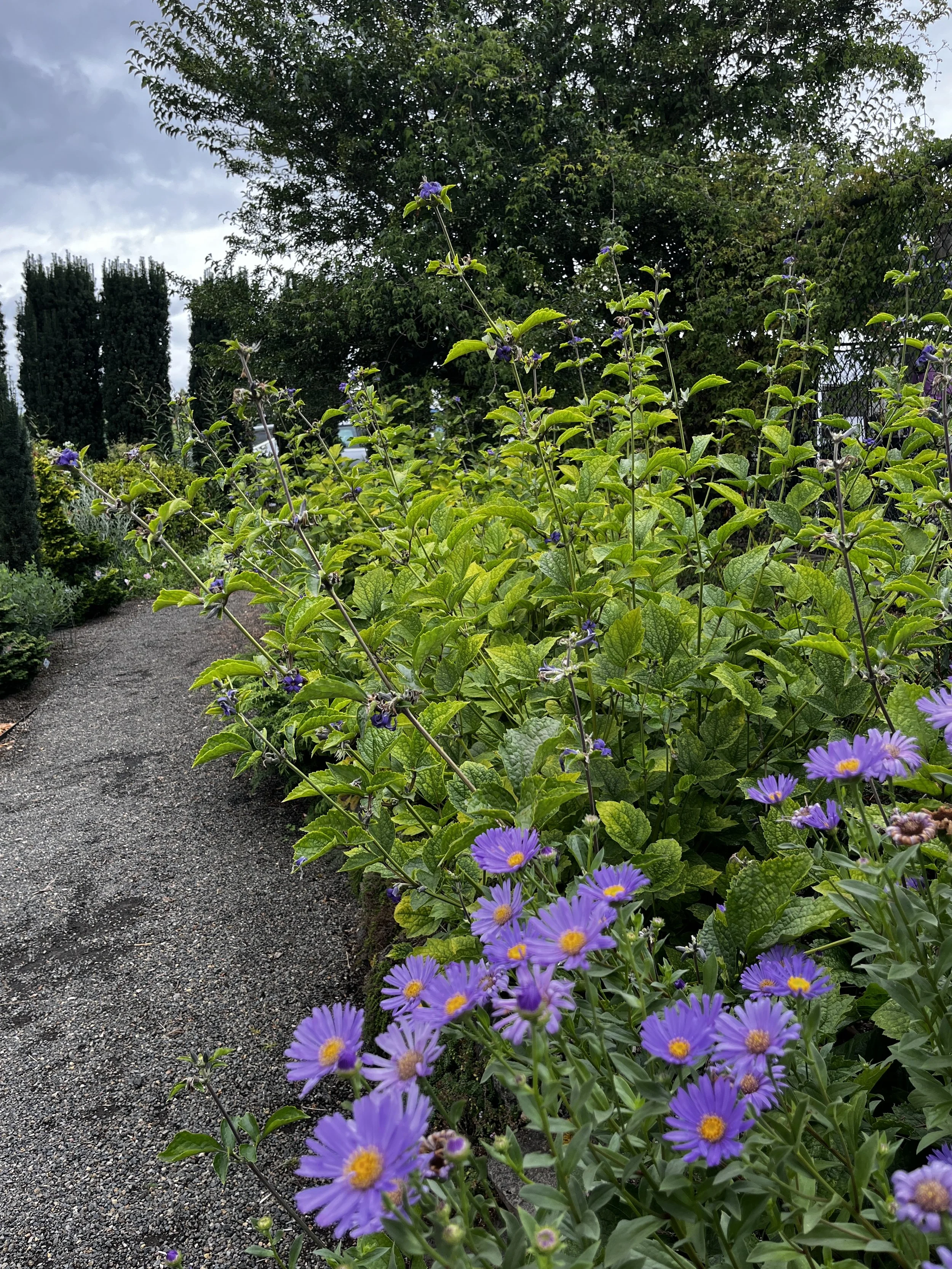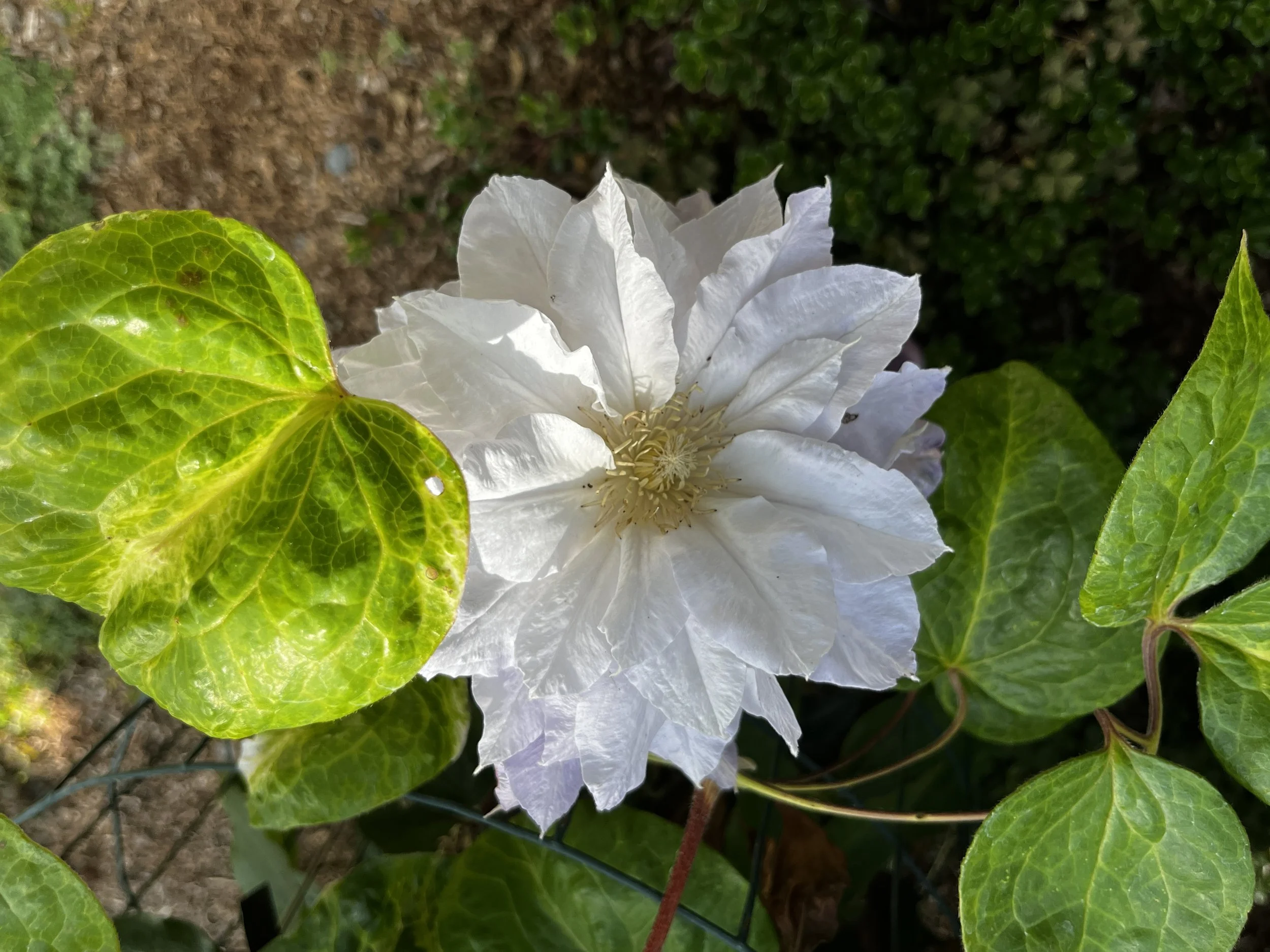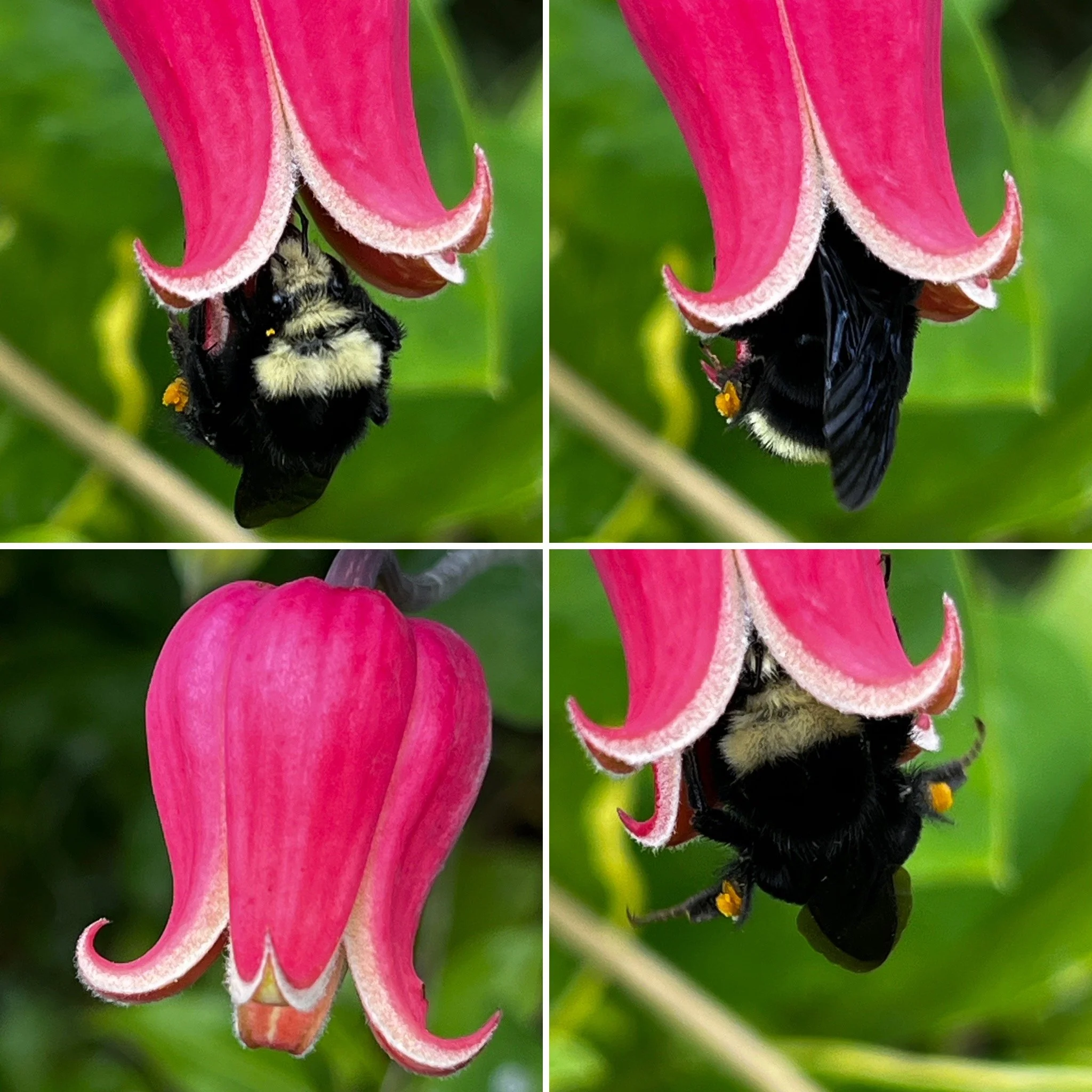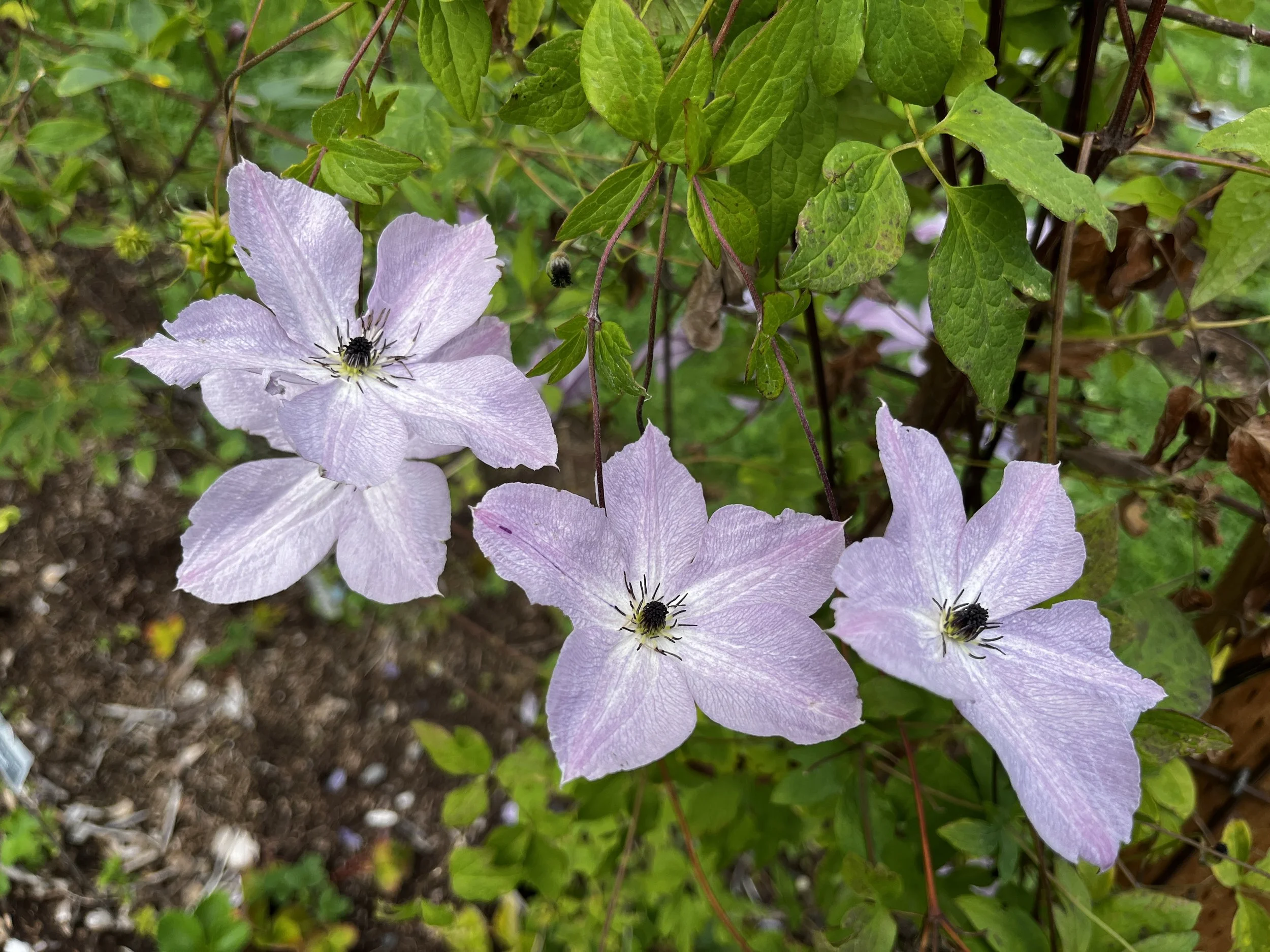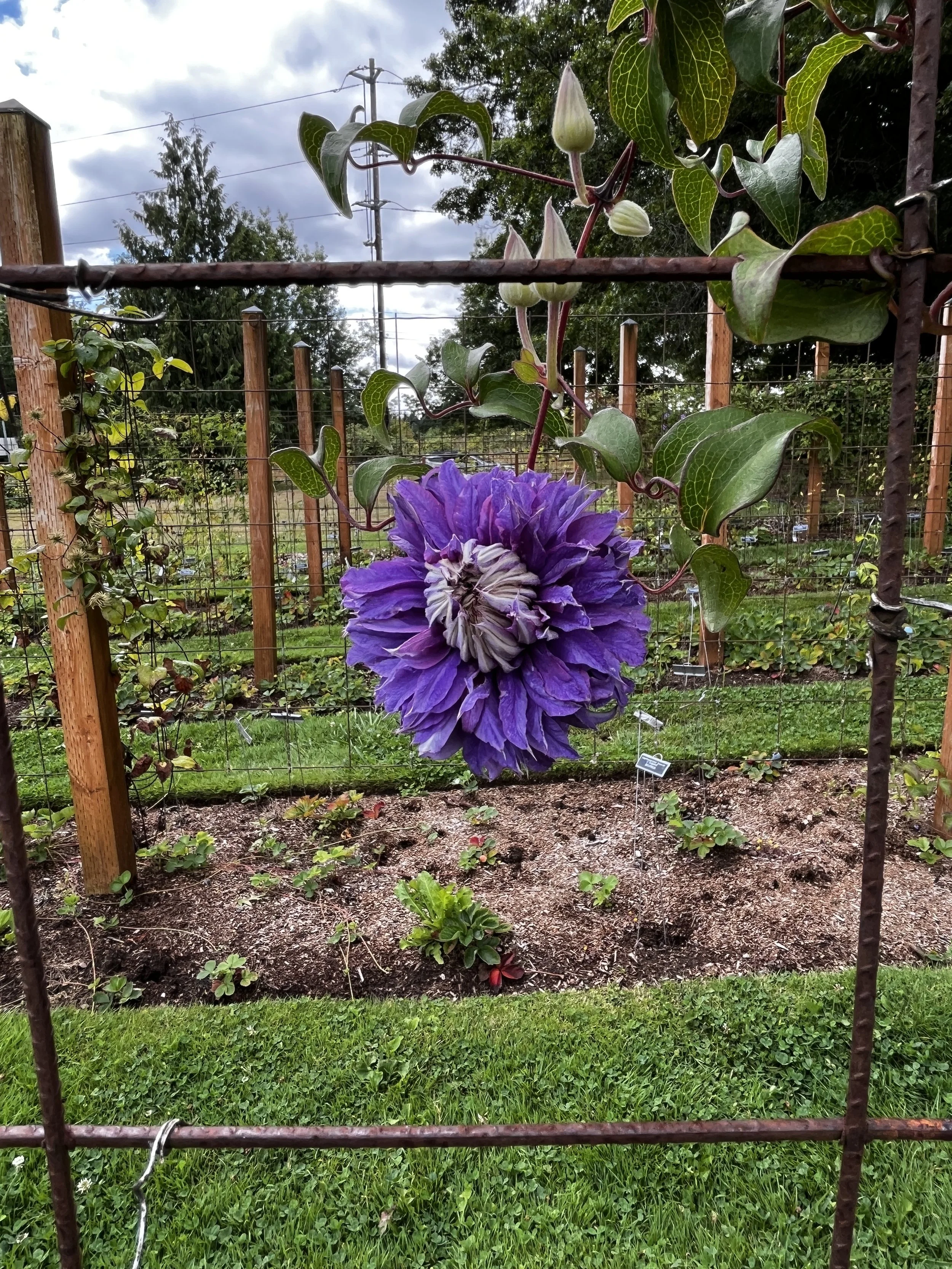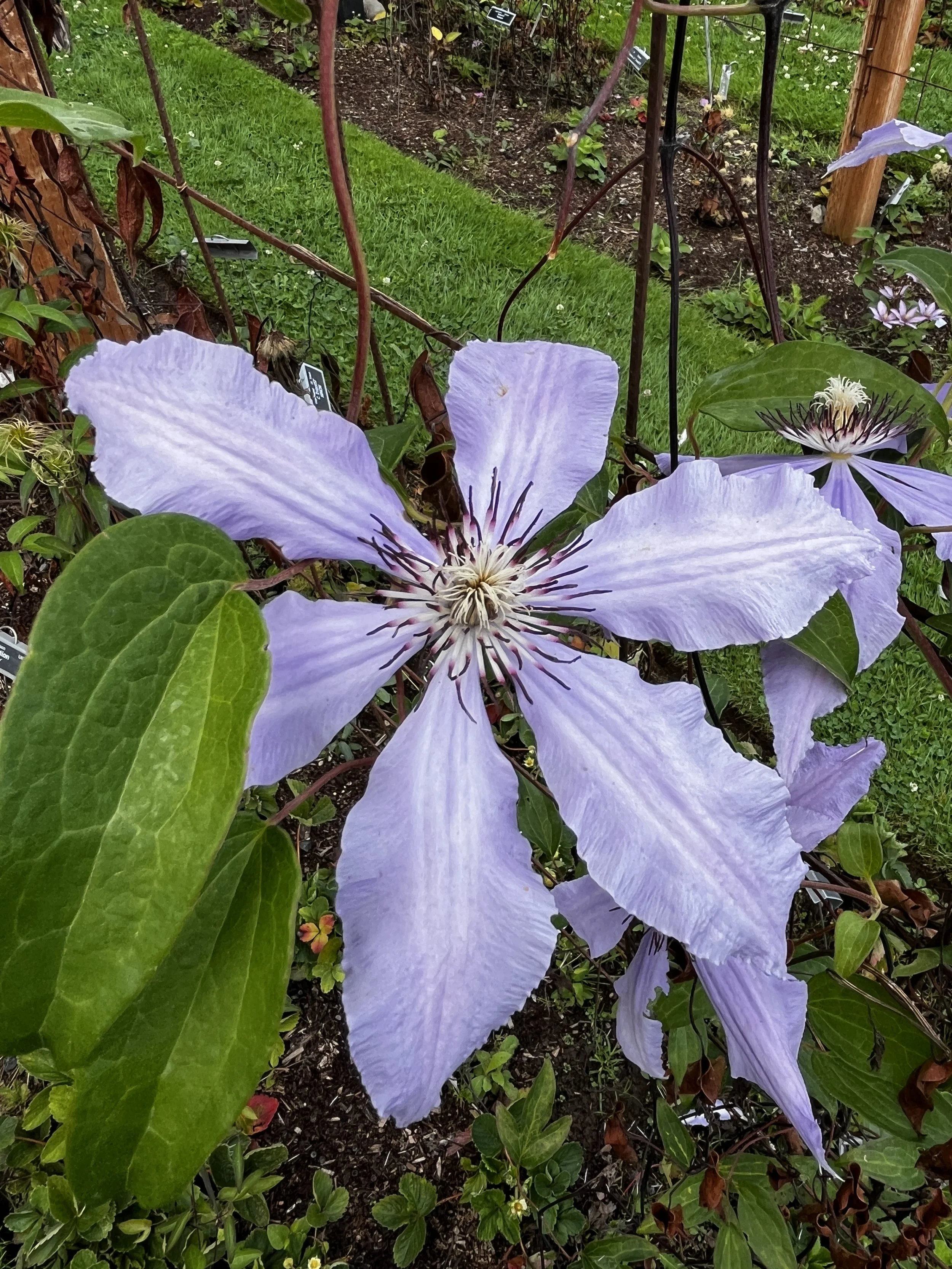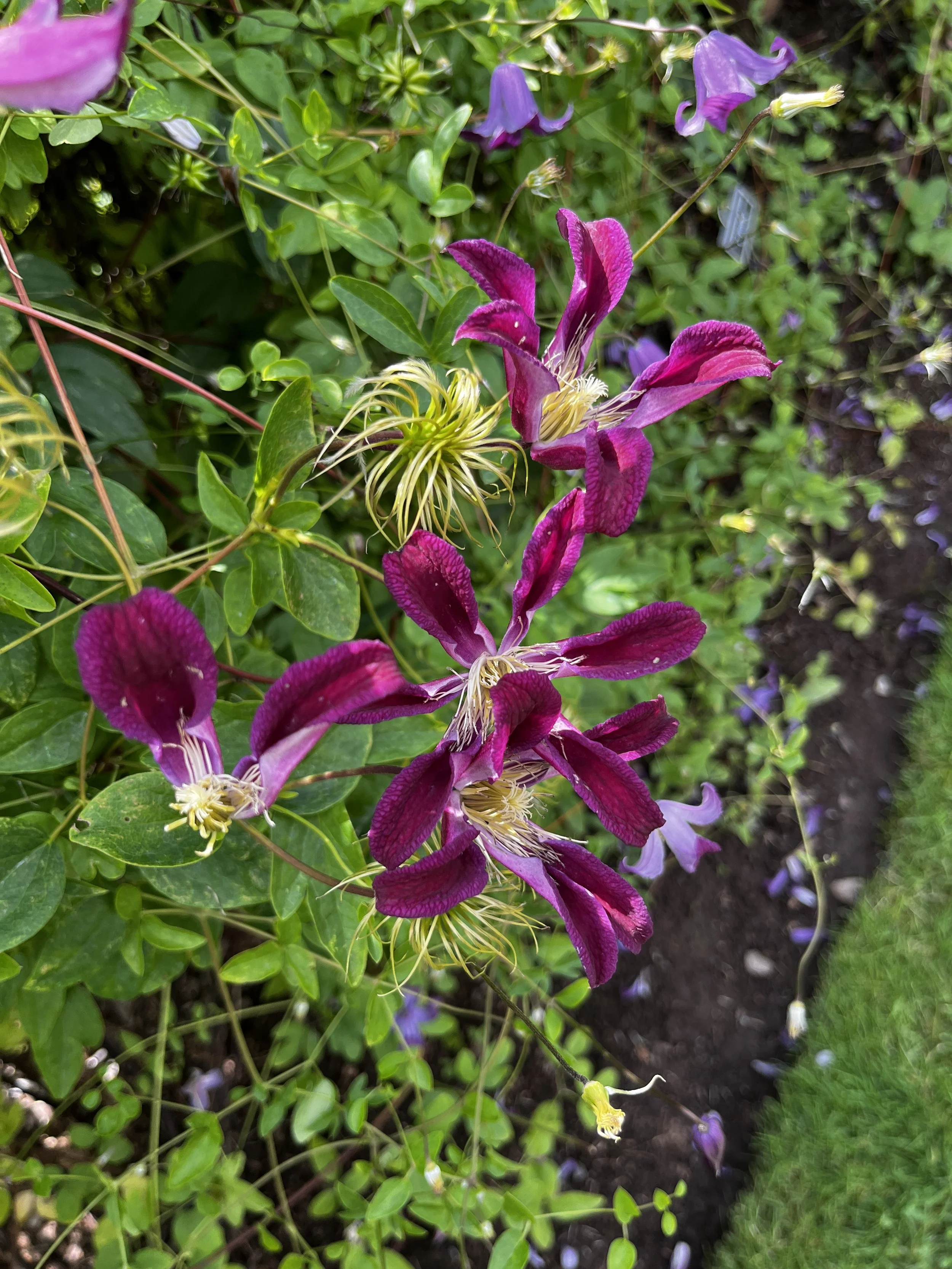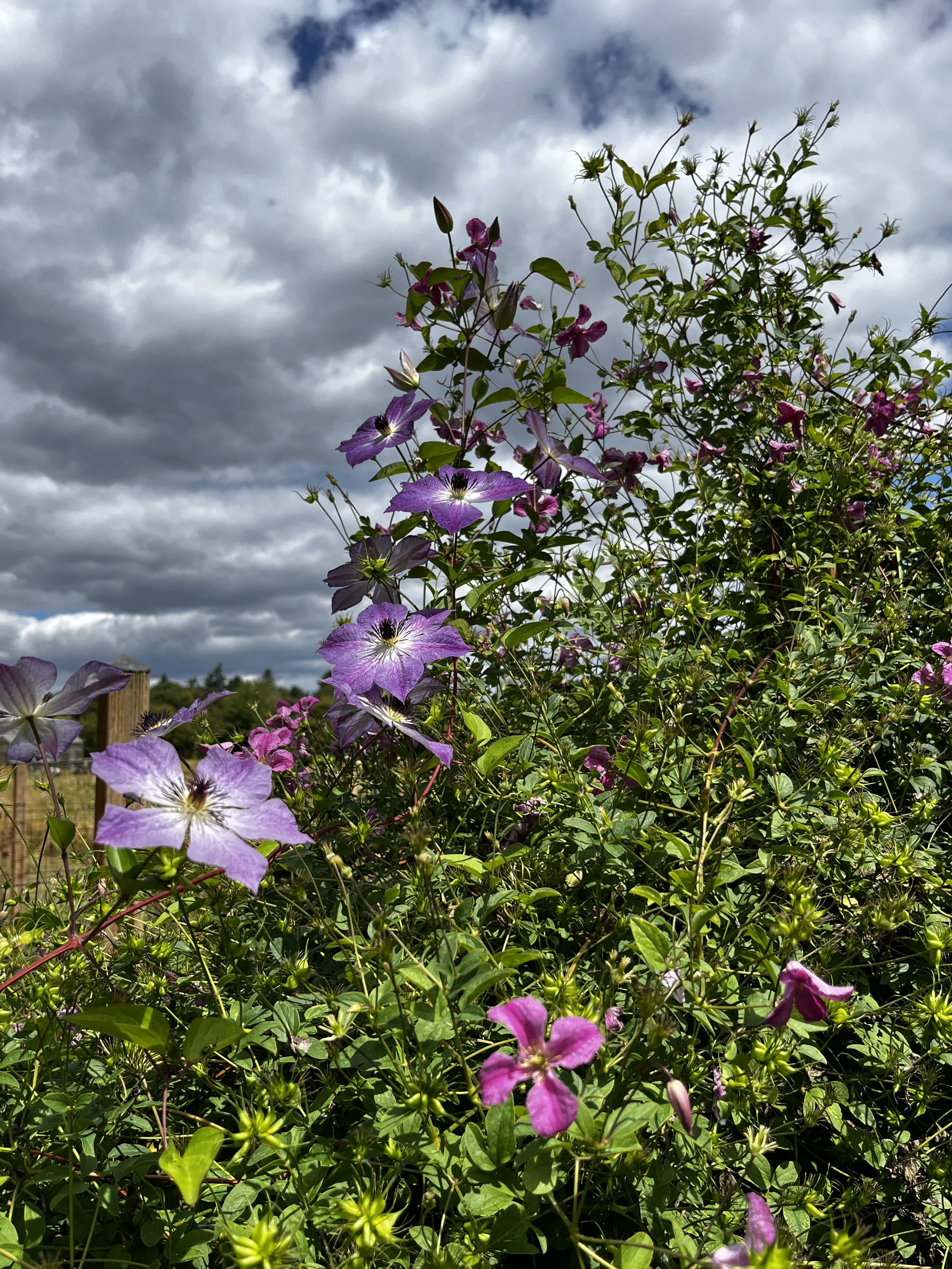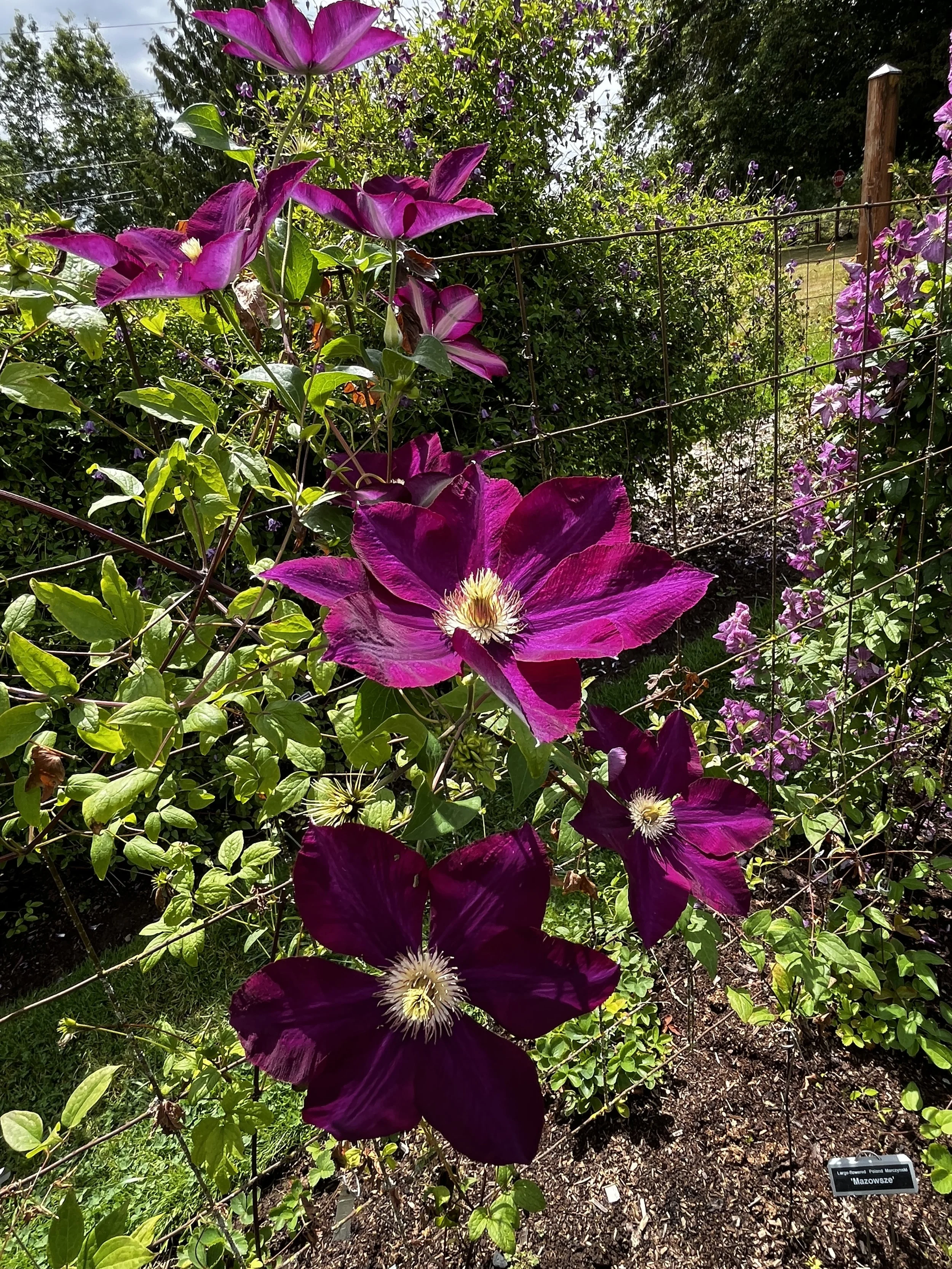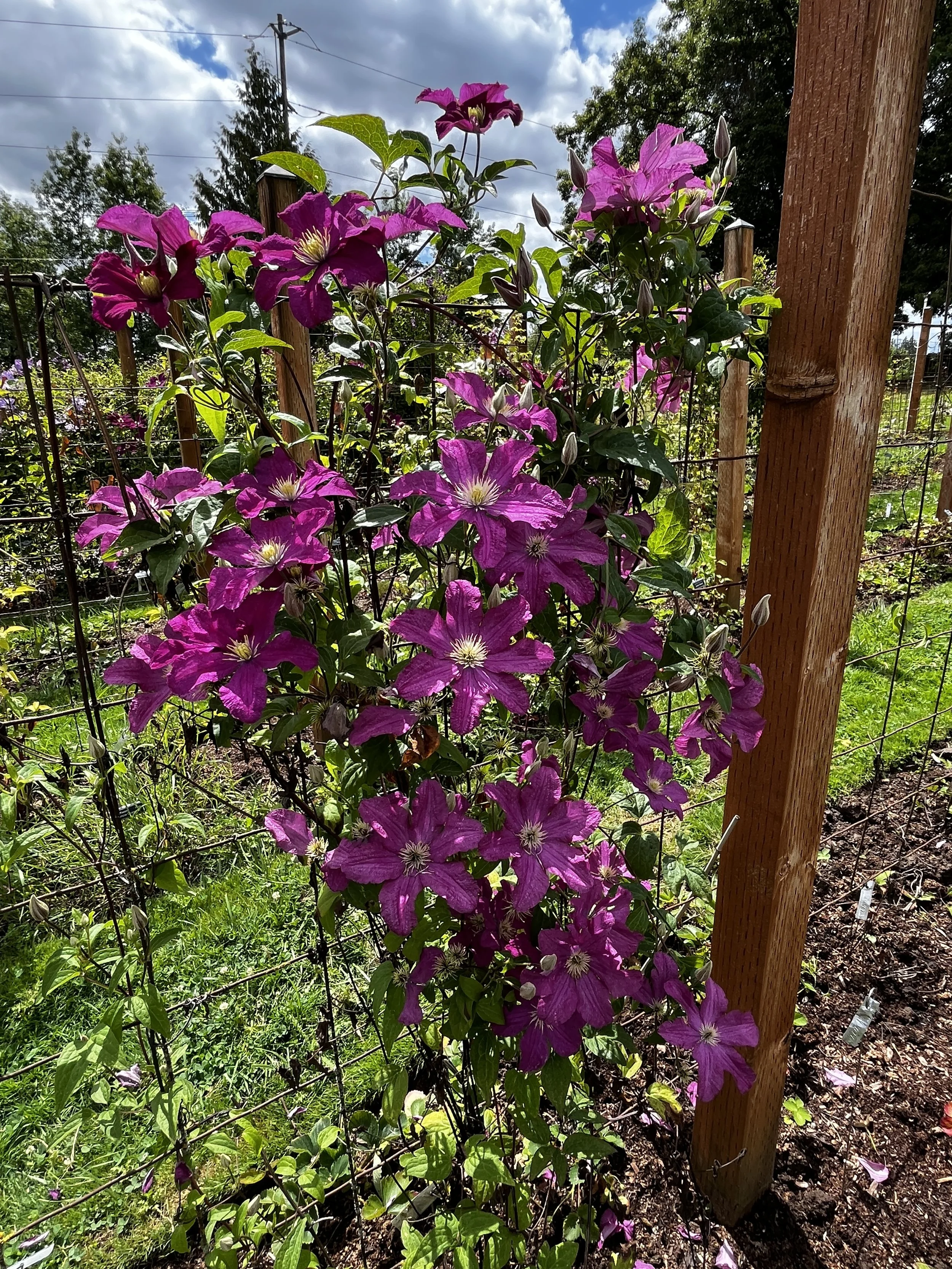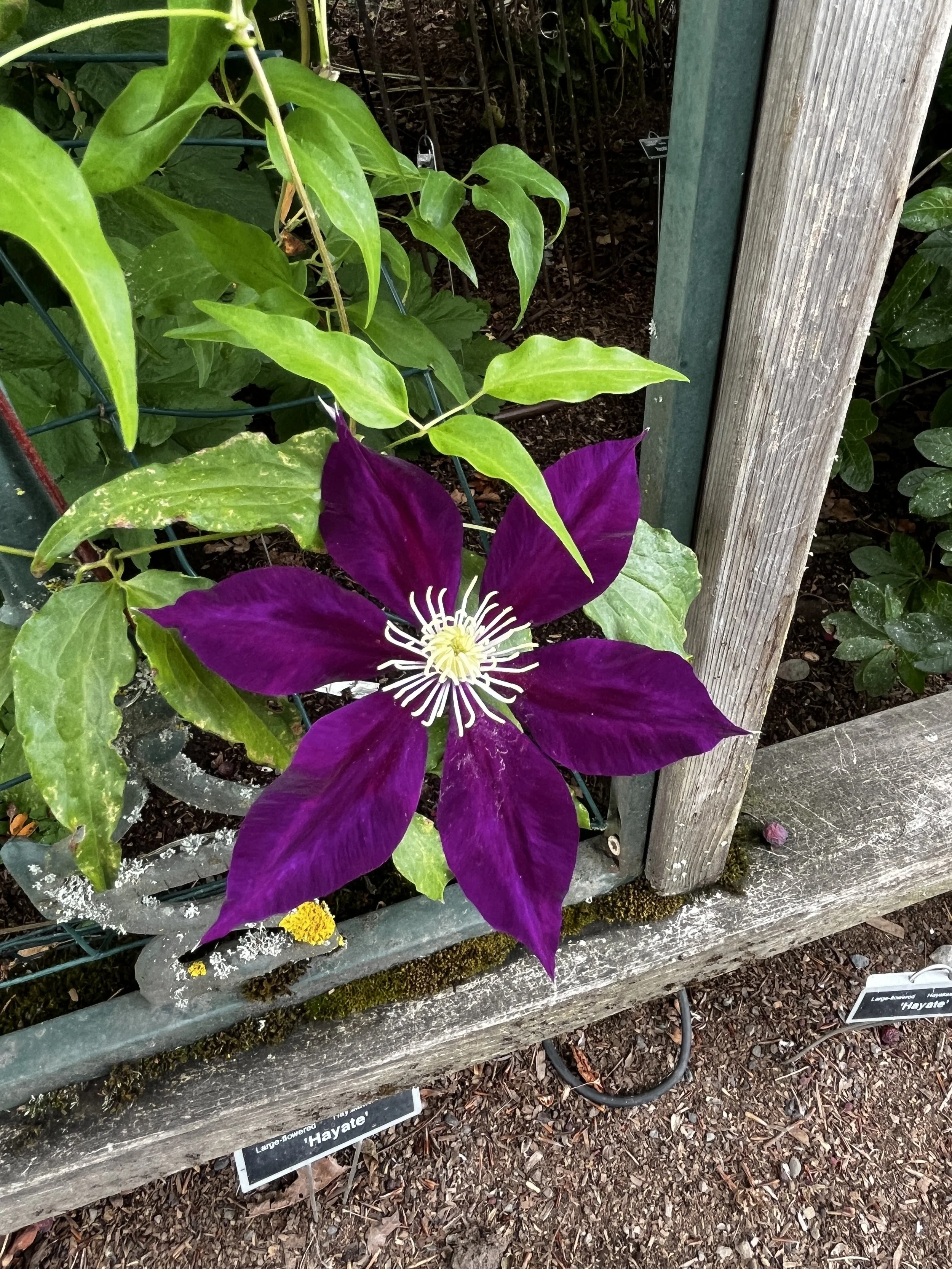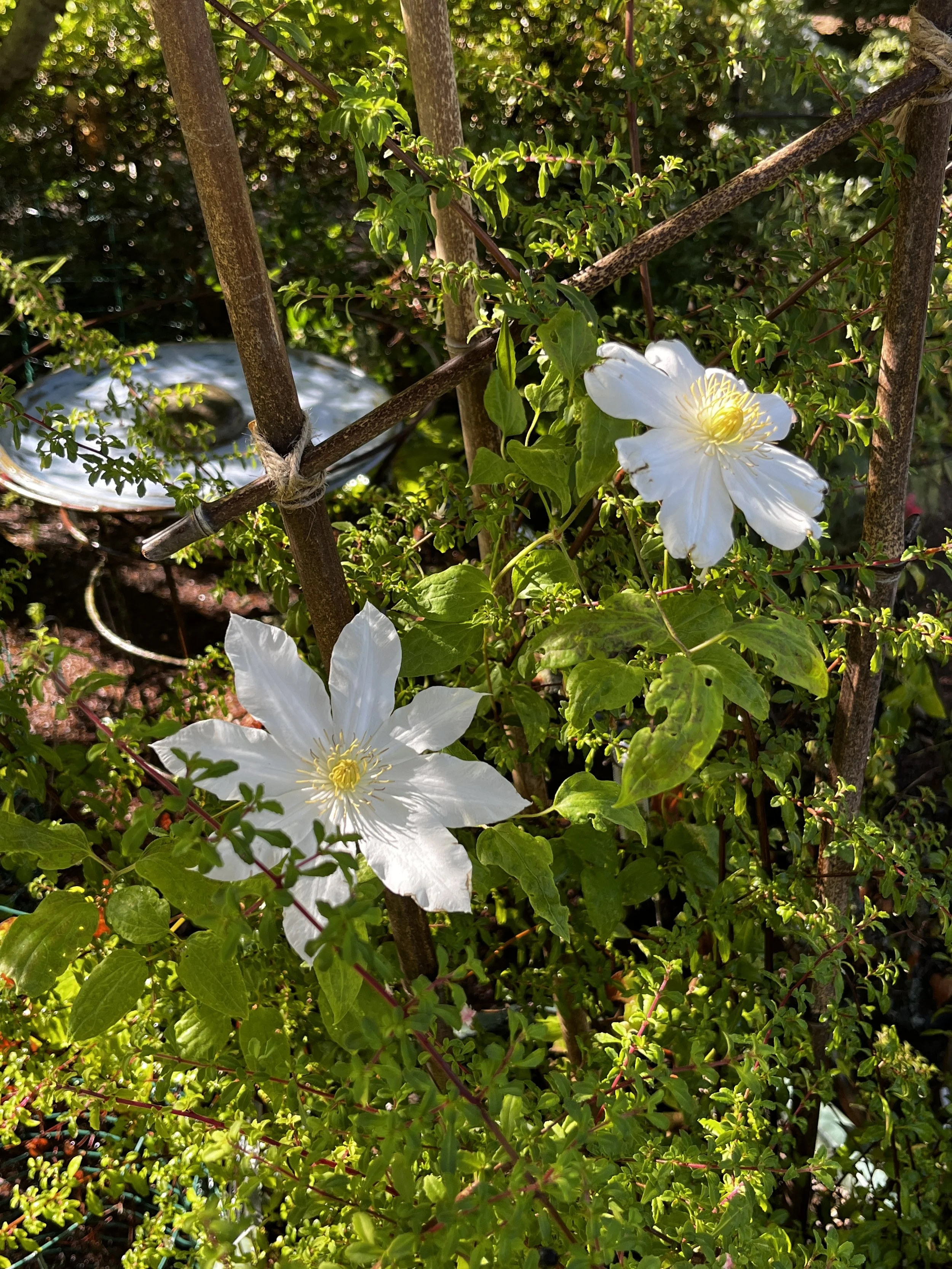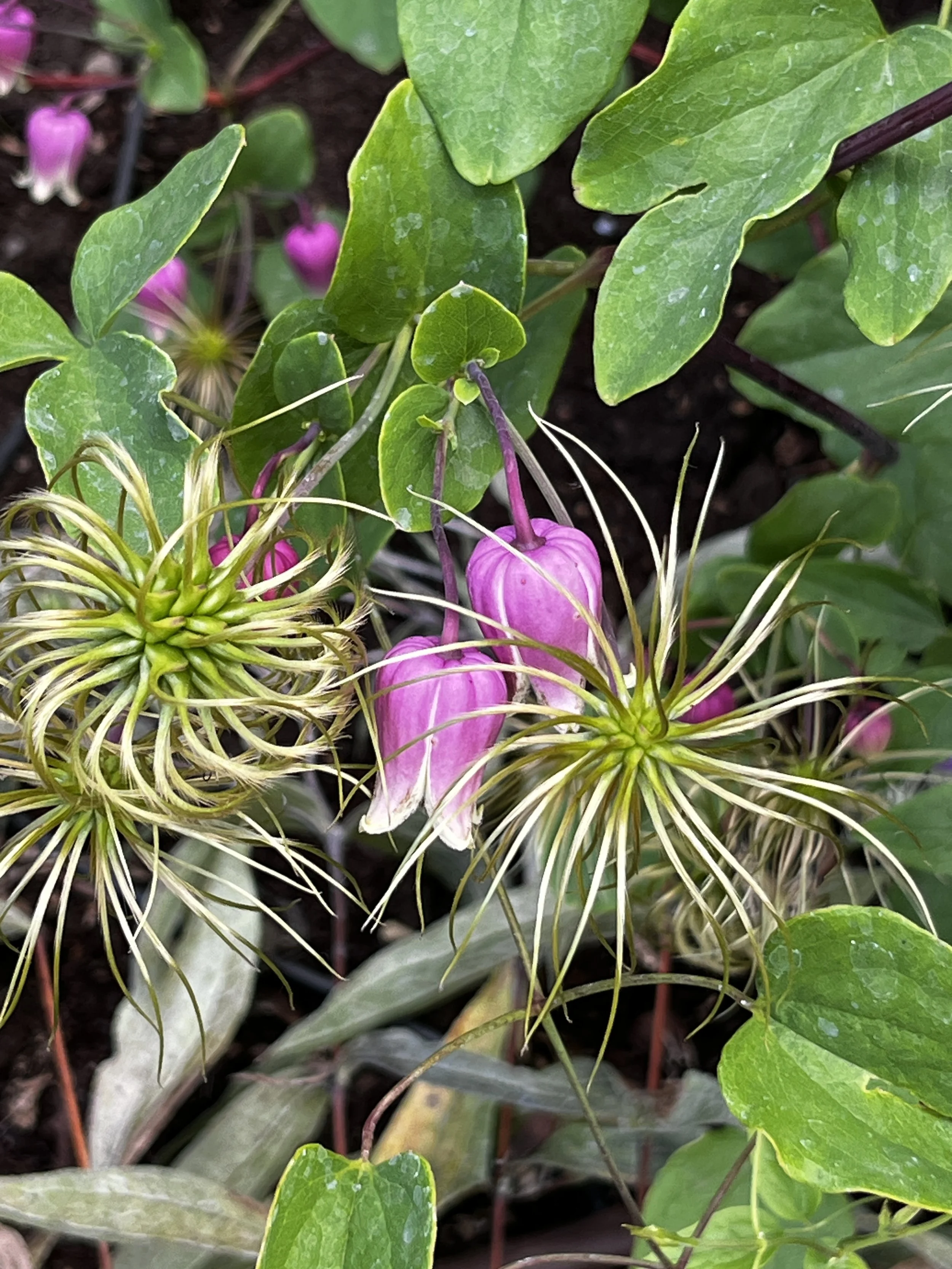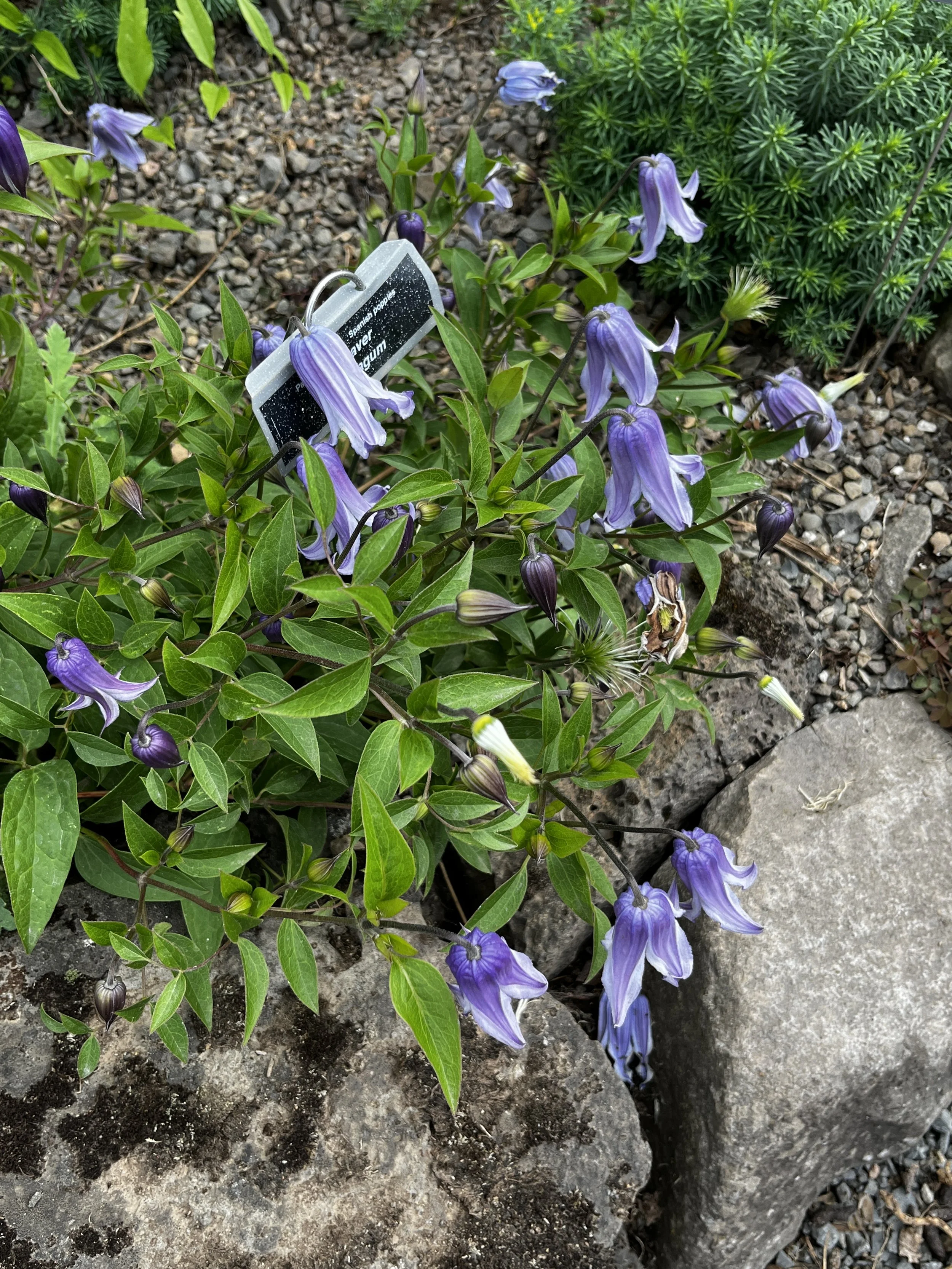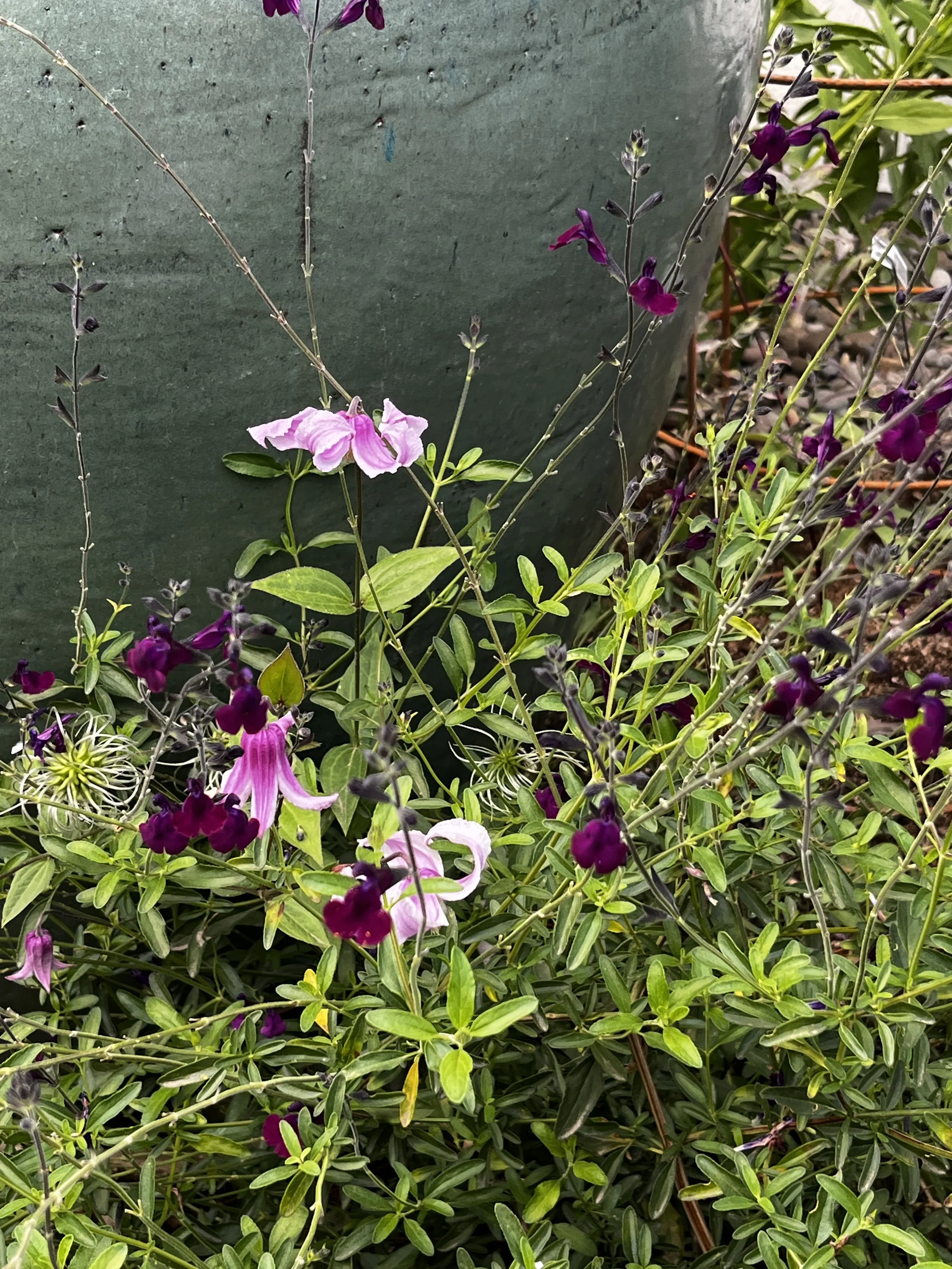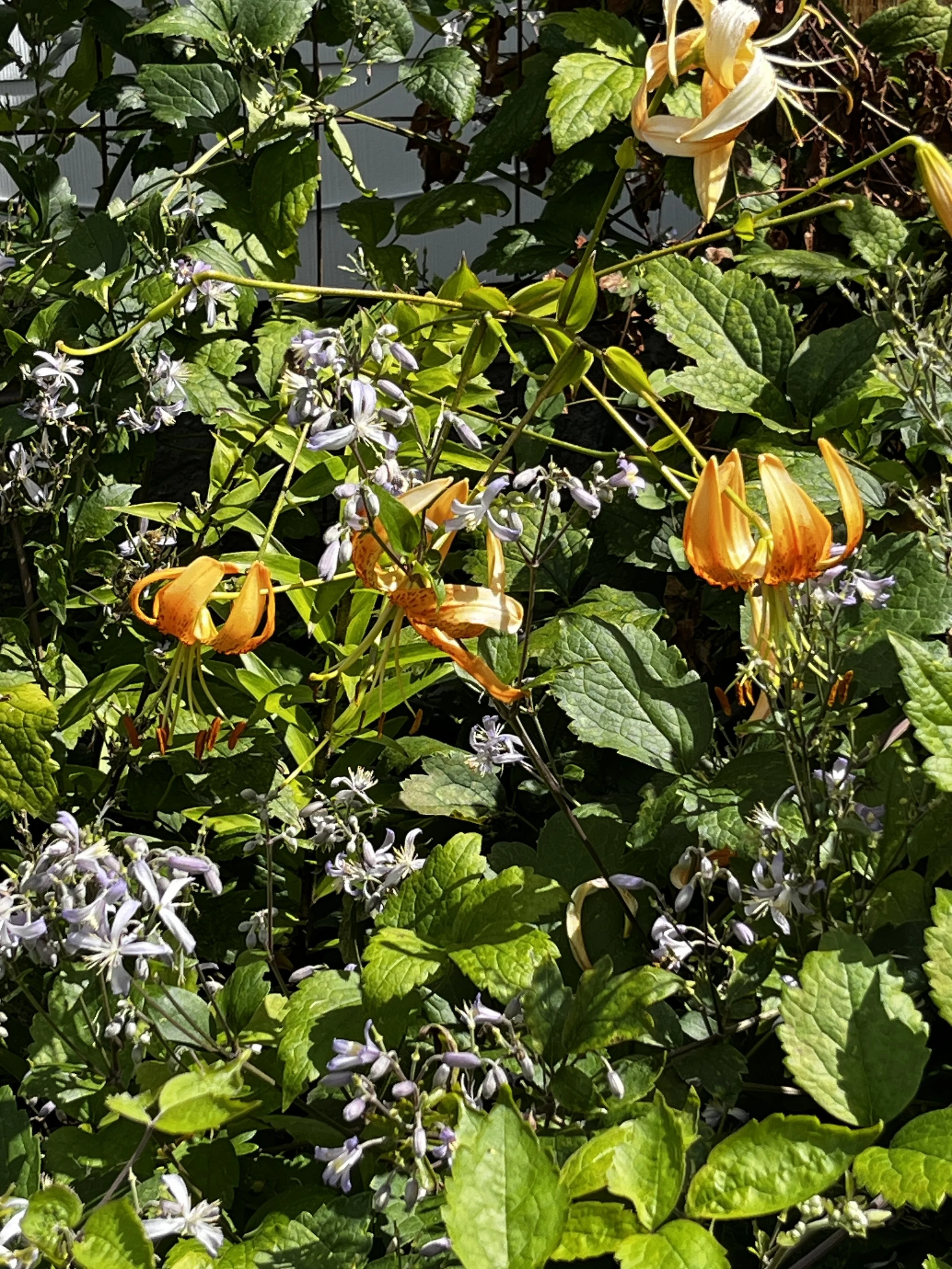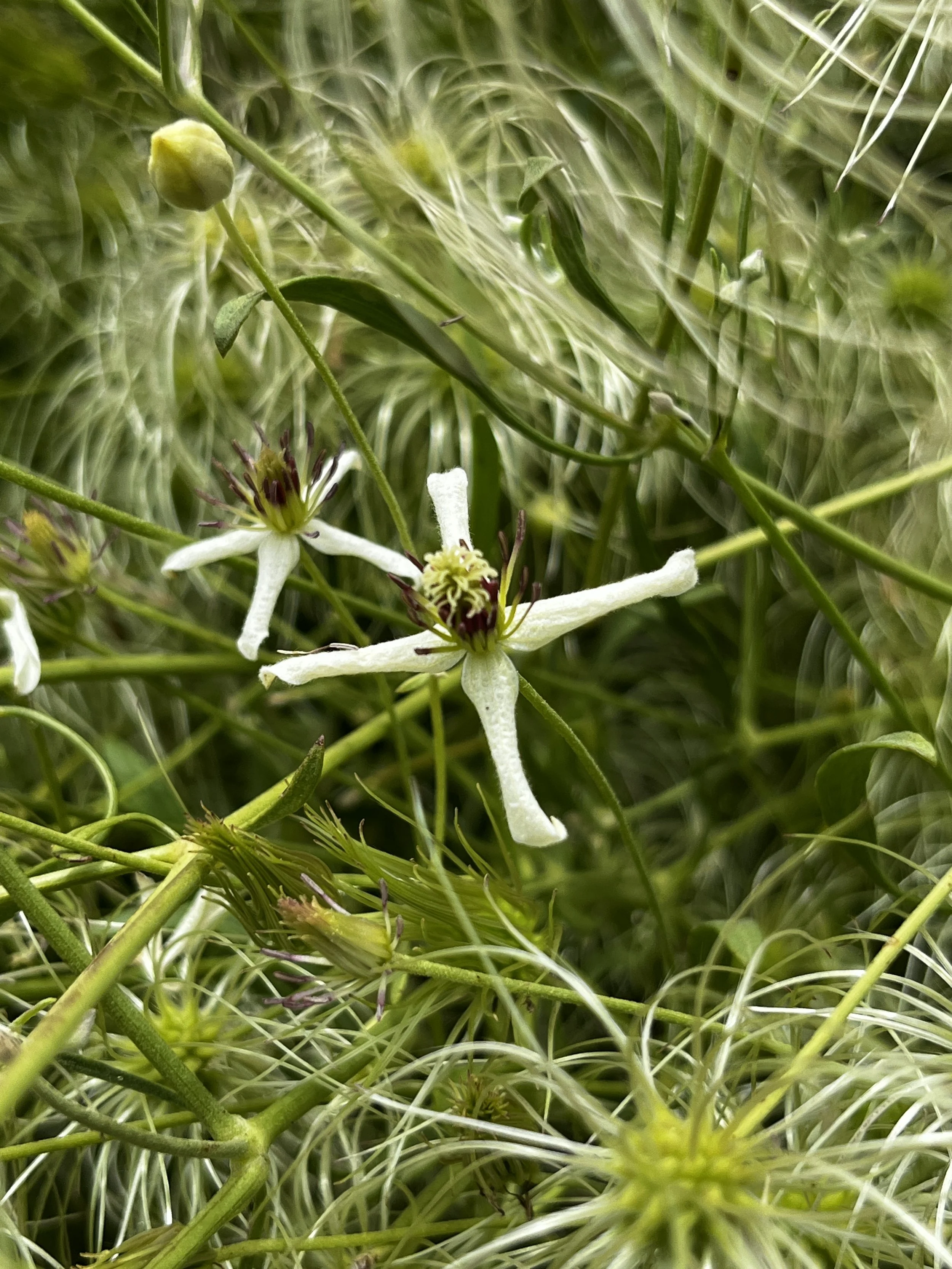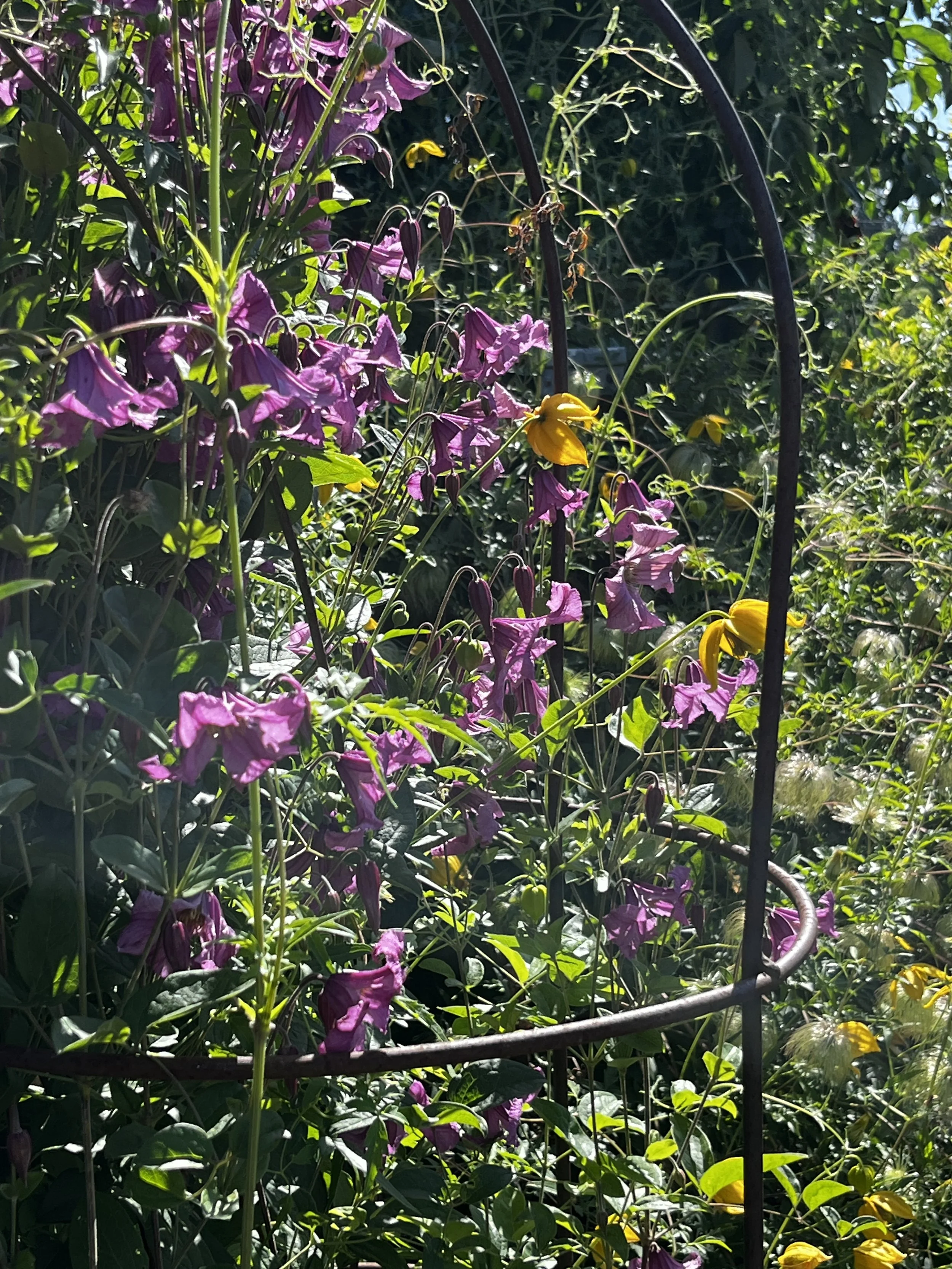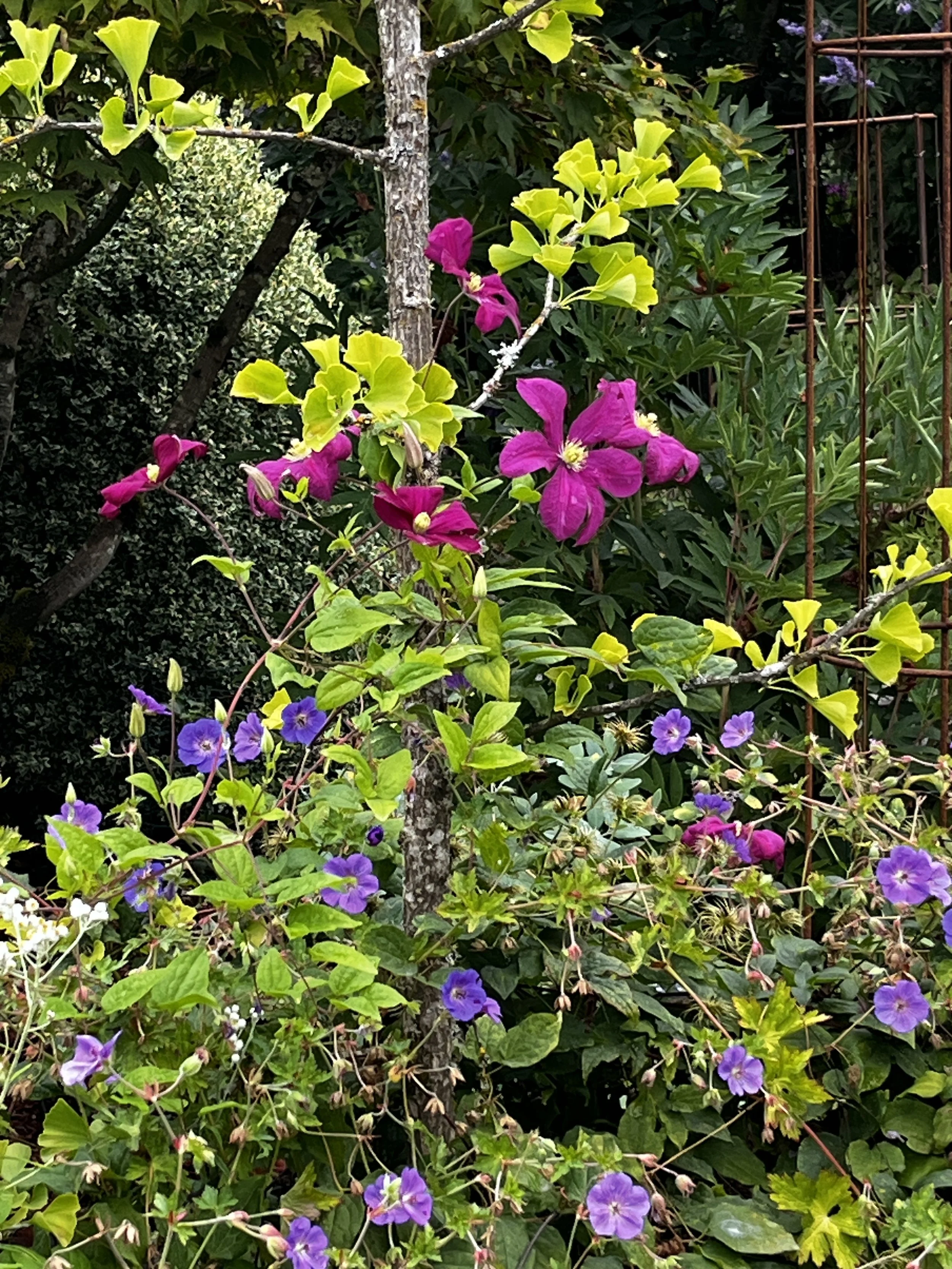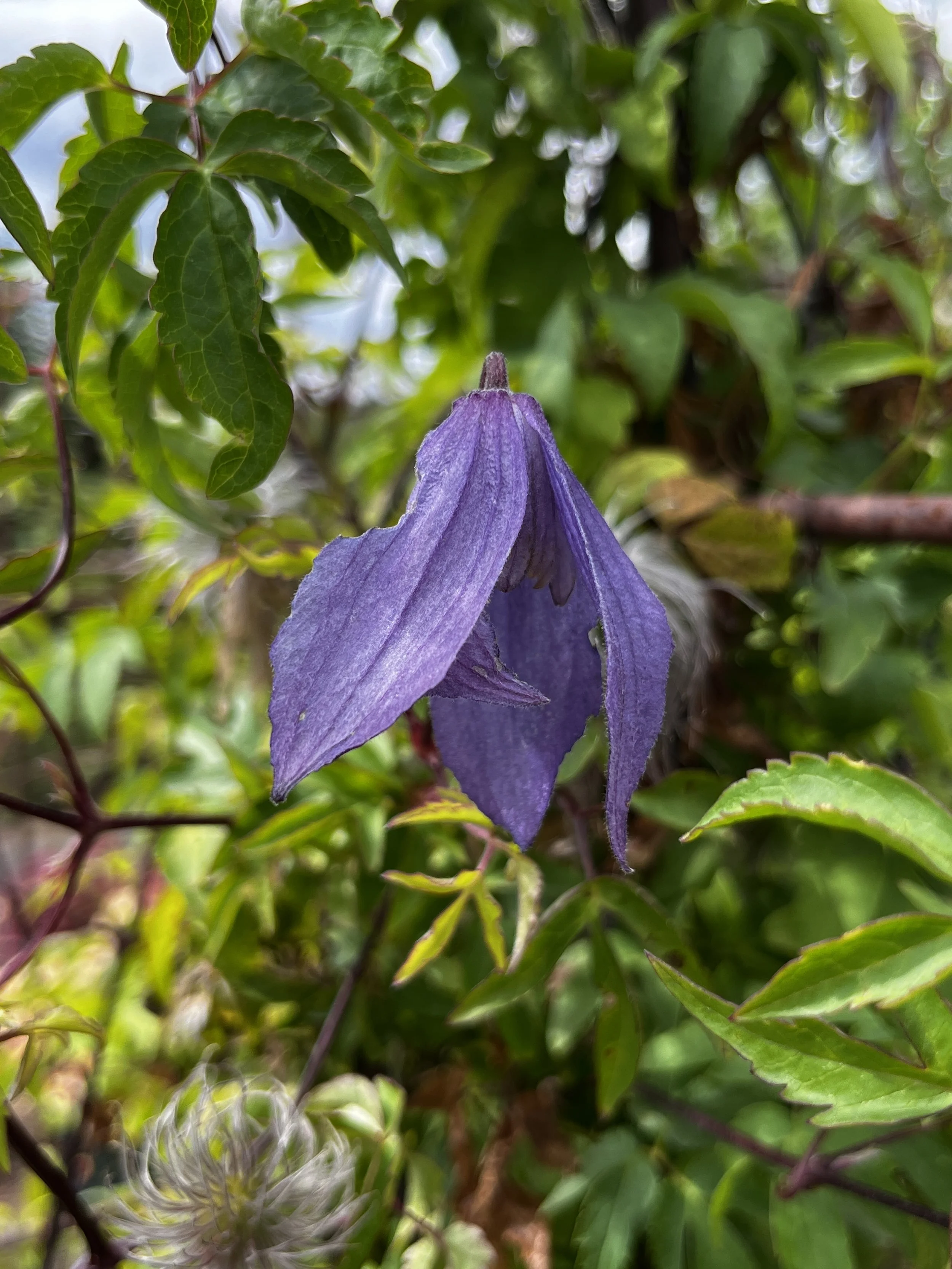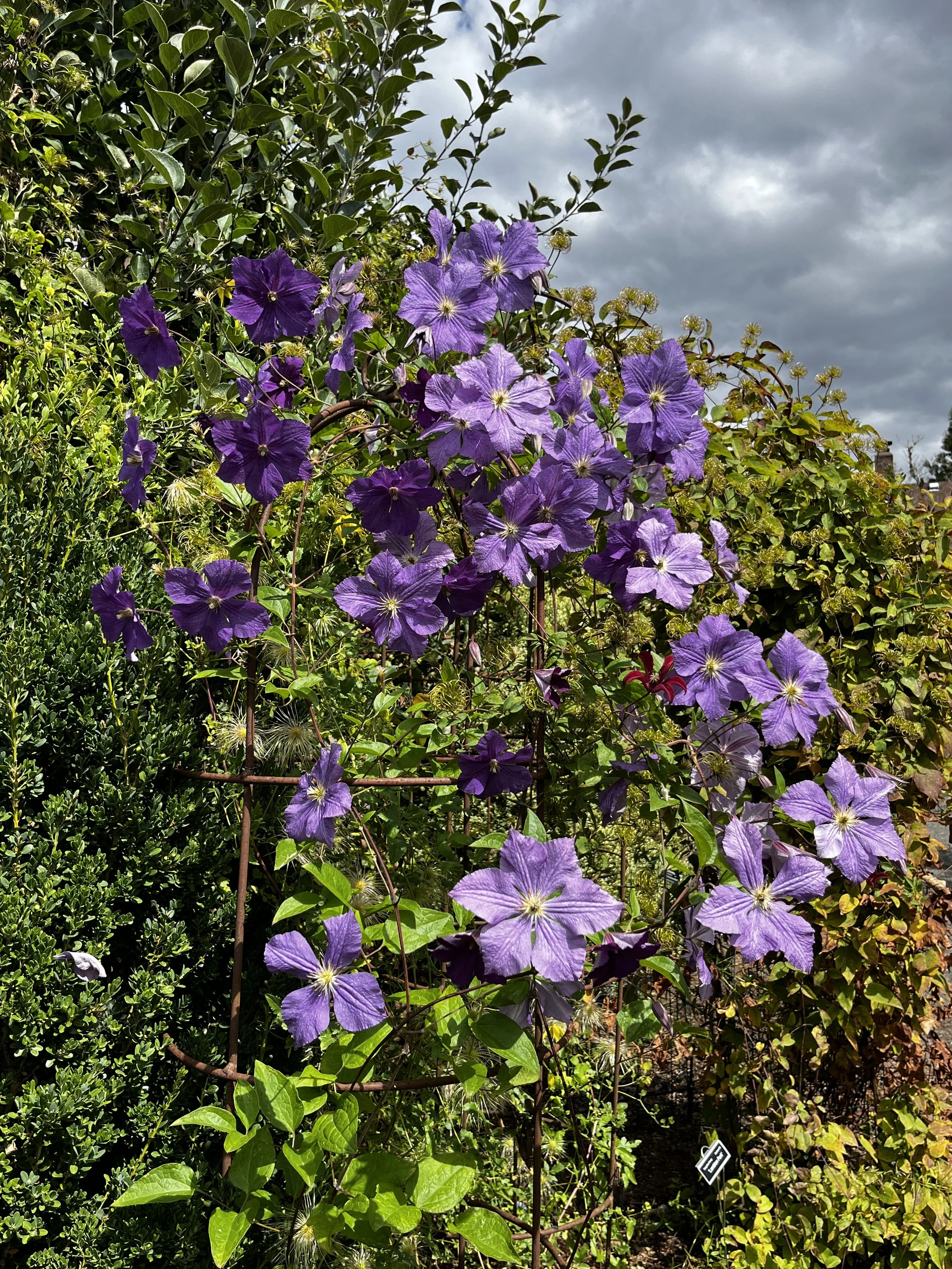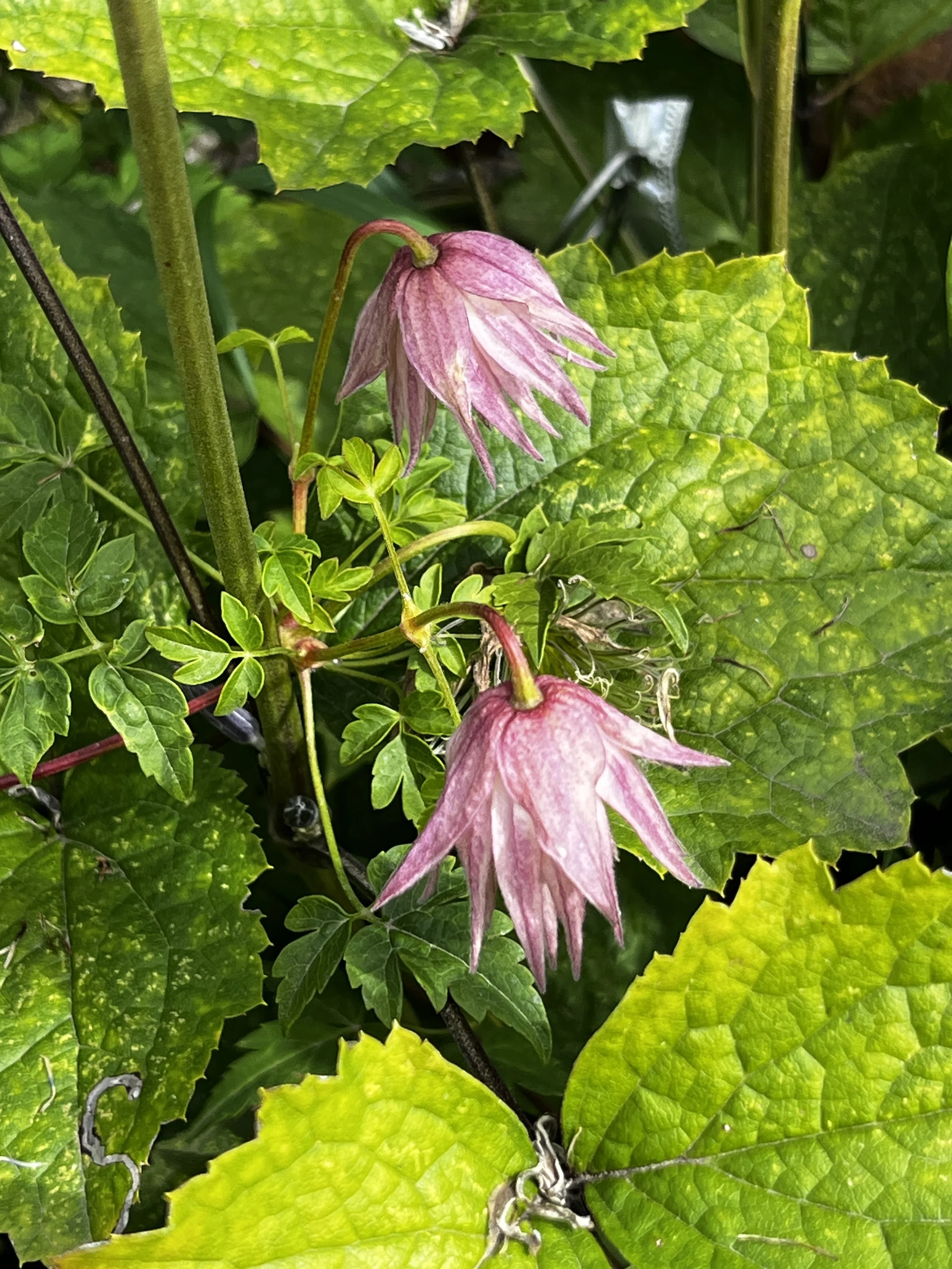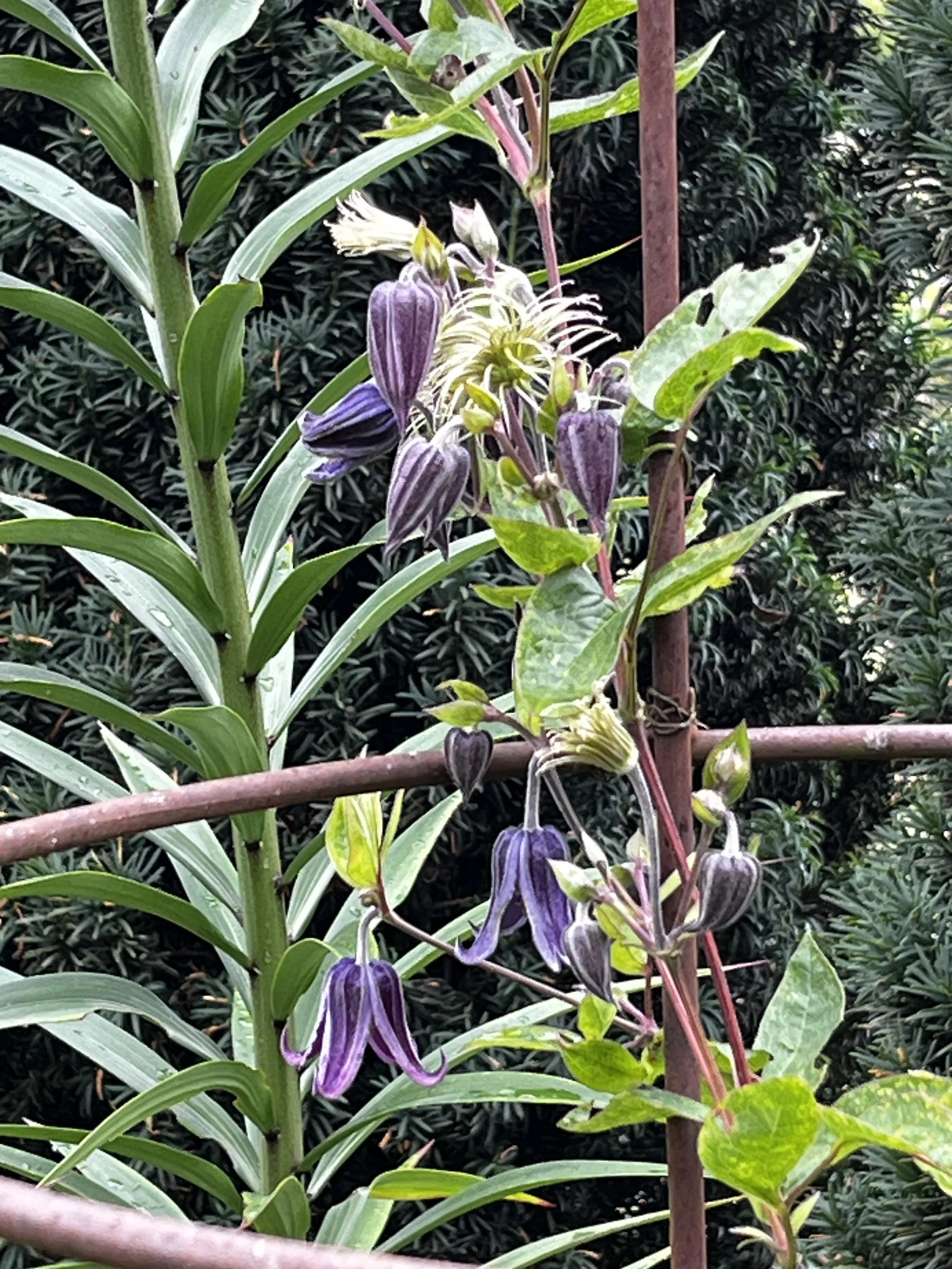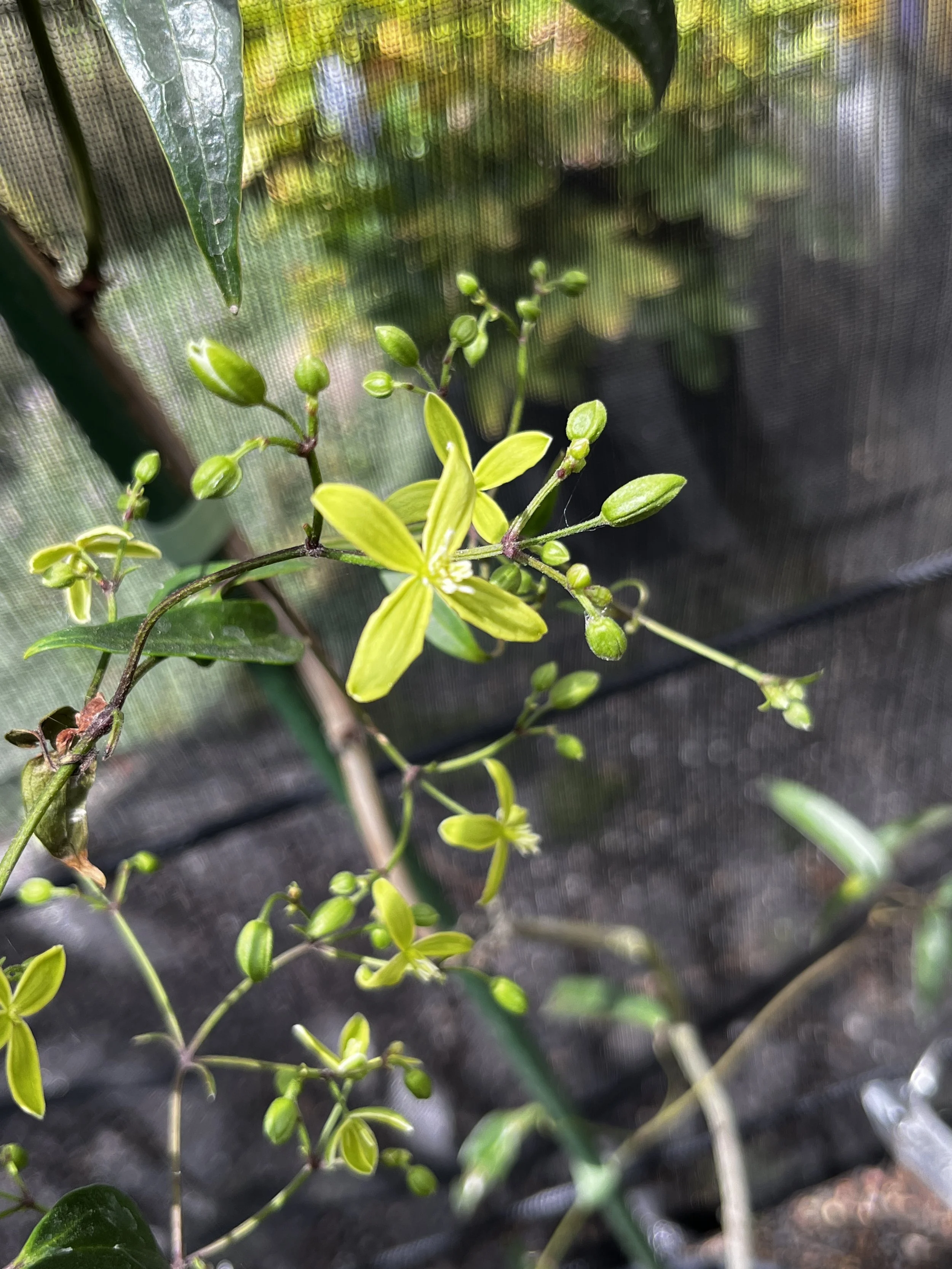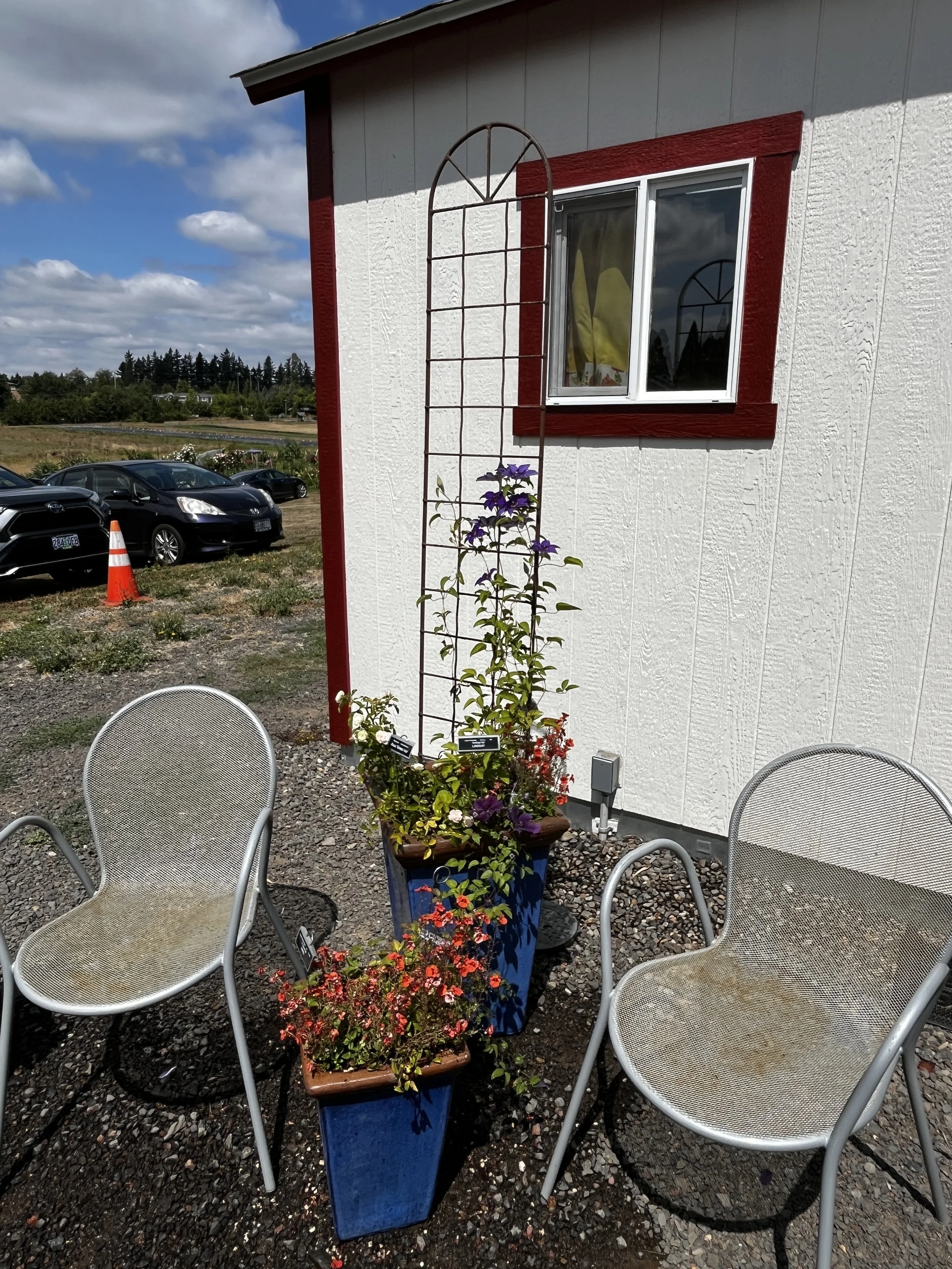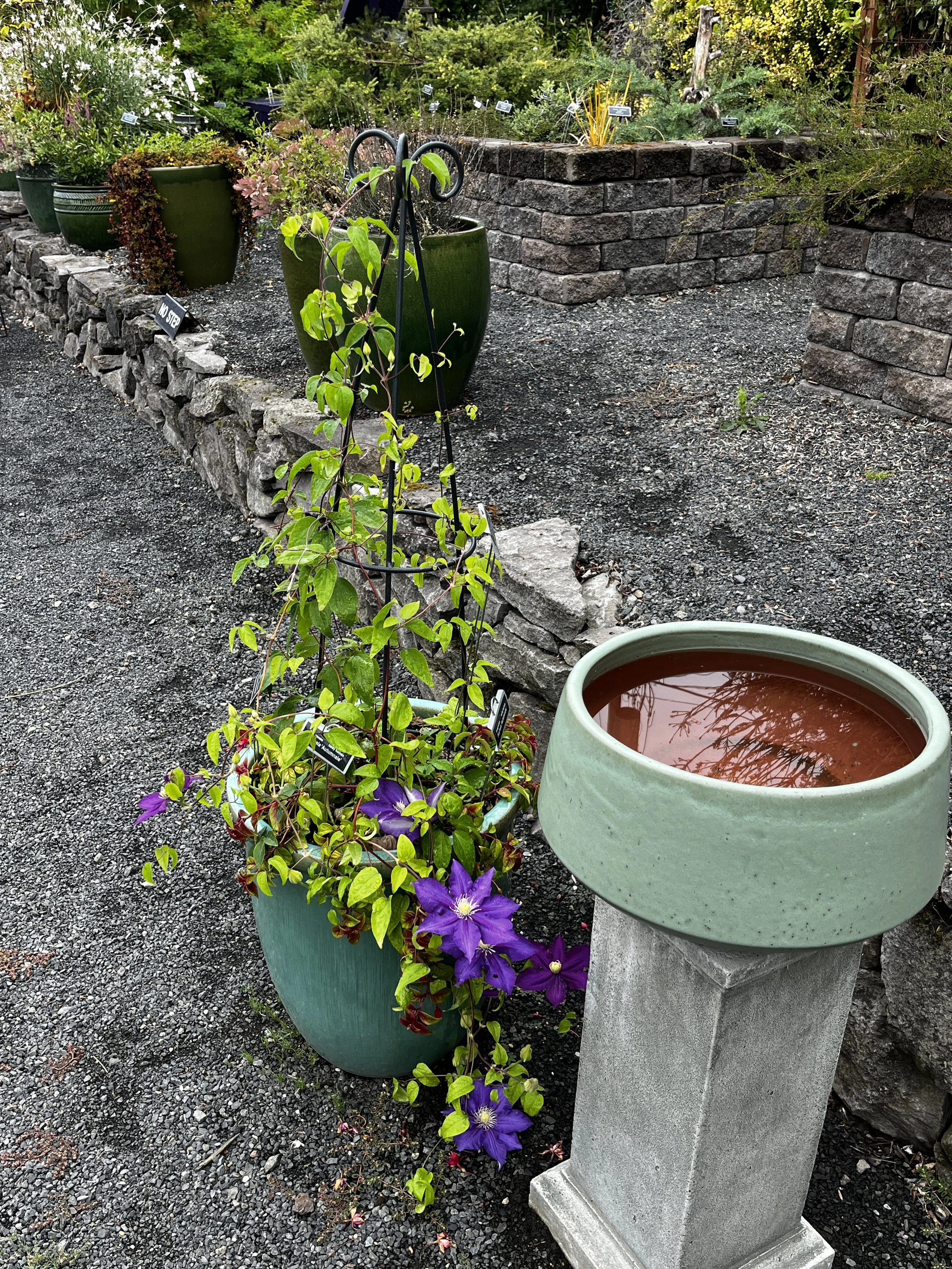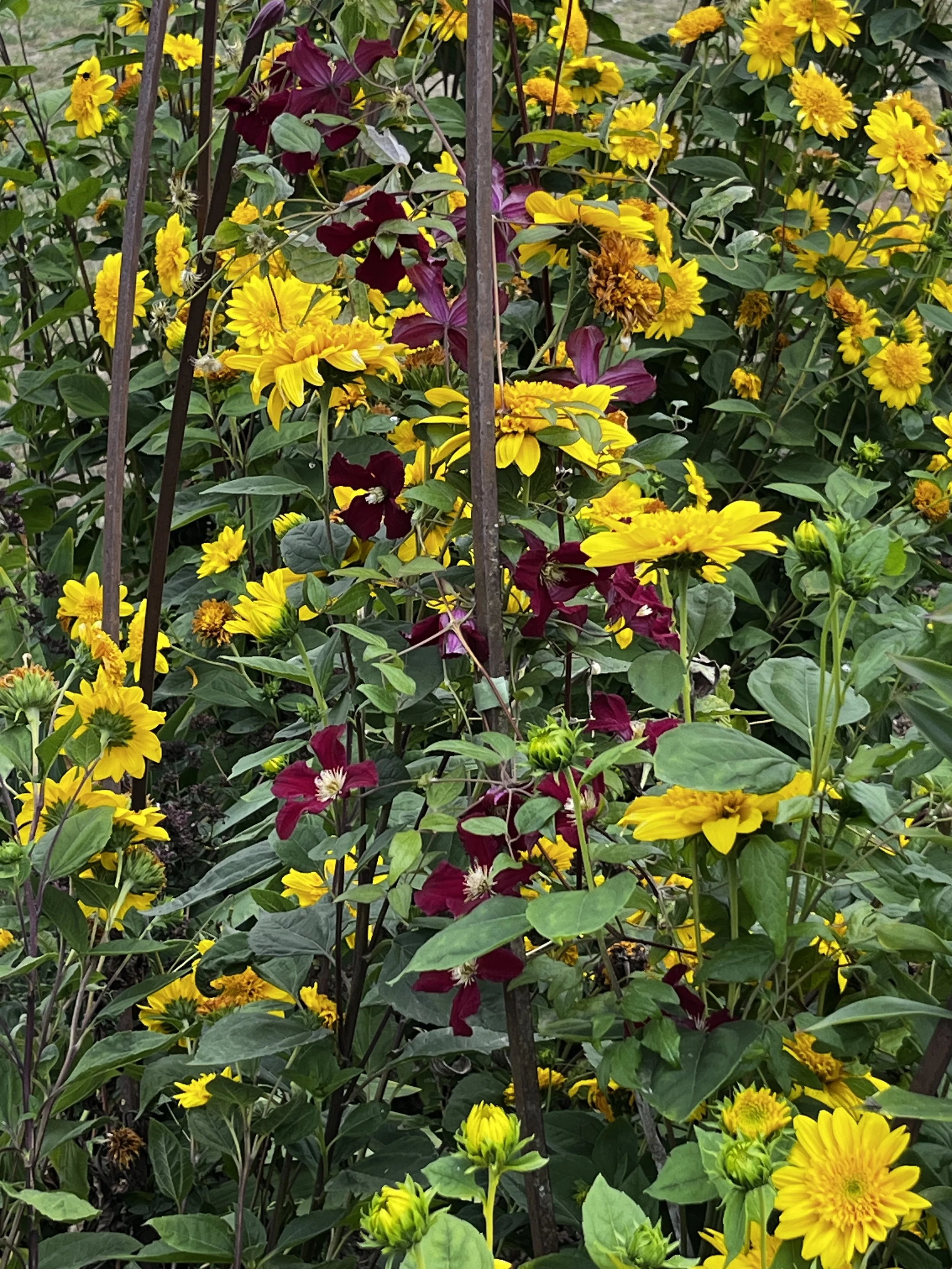What's in Bloom?
There are always clematis blooming in the garden! See below for a complete list of this week's blooms, plus a map to help you find each theme garden and bed number.
Updated August 11, 2025: We have 209 clematis in bloom, even though not long after peak bloom in early July, we begin cutting back clematis that had either begun a post-blooming pout, or were looking rather over-worked, like the herbaceous perennial clematis. Here we are in mid-August and those cut back in mid-July are already back in bloom.
For those of you on Facebook, look for us at Rogerson Clematis Garden. We’re on Instagram at @rogersonclematis as well as Rogerson Clematis Garden.
Visit CLEMATIS SALES: ONSITE sales and ONLINE ordering!
Visit CLEMATIS CARE for information sheets on growing clematis. If your questions are not answered there, call or text FRCC at 971-777-4394. Also, for a more detailed response, or to send photos for clematis identification, please email info@rogersonclematiscollection.org
Clematis otophora from China has begin its bloom season and will continue until late autumn. Bed 5
Bed 23 is in its full glory, with wands of Clematis tubulosa and heracleifolia hybrids and selections in full and fragrant bloom, interspersed with fluffy mounds of long-blooming Aster x frikartii ‘Jungfrau’. The main clematis here is C. heracleifolia ‘Blue Mood’.
In Bed 16, the Founder’s Garden, ‘Chalcedony’’ is showing us why it was a favorite of Brewster Rogerson’s.
Clematis ‘Anna Karolina’ wanders through our native pearly everlasting, Anaphalis margaritacea. This native is extremely popular with our native pollinating insects. Bed 20
A clip-on macro lens allows us to capture both intimate details of Clematis glaucophylla flowers as well as busy pollinators, like this Yellow-faced Bumblebee. Bed 7
OTHER PLANTS
We have just a handful of daylilies in the Rogerson Clematis Garden, and most are heirlooms, such as Hemerocallis citrina, also known as the lemon lily (but more than one daylily species has this common name). It has a long period of bloom and a wonderful scent. This specimen has ‘Comtesse de Bouchaud’ in the background. Heirloom Garden Bed 10
The Modern Garden
The seed heads of ‘Beautiful Bride’ give witness to how many flowers this cultivar can produce early on, and the plant is still going! Bred by Szczepan Marczynski. Row 10
At the end of each row along the center aisle is a modern non-climbing hybrid or very short-growing vining cultivar.
ROW 1, Profuse summer bloomers related to C. viticella and some summer urn/trumpet hybrids related to C. texensis
‘Aotearoa’, ‘Zo09085’ ASTRA NOVA, ‘Zo09088’ SUPER NOVA, ‘Fairy Dust’, and at the aisle end the short-growing ‘Elf’
Many of the viticella-type clematis in Row 1 have been cut back to encourage autumn rebloom, but ‘Fairydust’ starts a little later than the others and is still in bloom.
ROW 2, Profuse summer bloomers and Pink large-flowered cultivars
Nothing in bloom for now
RAYMOND EVISON HYBRIDS (Rows 3-7)
‘Evipo039’ DIAMANTINA starting a new cluster of puffball flowers, Row 5
ROW 3, Evison Hybrids
‘Evipo033’ AVANT-GARDE, at the aisle end ‘Evipo014’ JESSICA
ROW 4, Evison Hybrids
‘Evipo021’ CHANTILLY, ‘Evipo022’ CHARMAINE, ‘Evipo090’ CHIE
ROW 5, Evison Hybrids
‘Evipo026’ DIANA’S DELIGHT, ‘Evipo039’ DIAMANTINA, 'Evipo011’ EMPRESS, ‘Evipo076’ ENDELLION
ROW 6, Evison Hybrid
‘Evipo042’ FLEURI, ‘Evipo084’ JIE, ‘Evijohill’ JOSEPHINE, ‘Evifive’ LIBERATION, ‘Masquerade’, at the aisle end ‘Evipo079’ NUBIA
ROW 7, Evison Hybrids
‘Evipo034’ PALETTE, ‘Evipo099’ OLYMPIA, ‘Evipo002’ ROSEMOOR, ‘Evipo077’ SALLY, ‘Evipo075’ SAMARITAN JO, ‘Evipo114’ VICKI, ‘Evipo111’ TRANQUILITE, ‘Evipo082’ YUAN
High, overcast light deepens the luster of ‘Evipo002’ ROSEMOOR. Row 7
ROW 8, Double large-flowered clematis
‘Blue Light’, ‘Kiri te Kanawa’, ‘Samantha Denny’ (single), ‘Zodaque’ DANCING QUEEN
ROW 9, Profuse flowering clematis (C. viticella and C. texensis hybrids)
at the aisle end ‘Lathkill Dale’, ‘Little Bas’, ‘Poldice’, ‘Pendragon’, ‘Zoprika’ PRINCESS KATE, PRINCE WILLIAM, ‘Ruby Wedding’
Barry Fretwell’s ‘Ruby Wedding’ may be cut back in midsummer, or let it continue to ramble along producing random new flowers, as seen here in Row 9.
WE WOULD LIKE TO HUMBLY REQUEST THAT, FOR THE FORESEEABLE FUTURE, CLEMATIS BREEDERS HOLD A MORATORIUM ON NAMING C. viticella and C. texensis HYBRIDS WITH CULTIVAR NAMES BEGINNING WITH ‘P’. WE CAN’T FIT ANYMORE IN THE ALLOTTED AREA, AND IT’S PLAYING HAVOC WITH THE ALPHABET. Thanks. ;-)
SZCZEPAN MARCZYNSKI HYBRIDS (Rows 10 & 11)
‘Cloudburst’ and ‘Krakowiak’ (pink bells) against a threatening sky. Row 10
ROW 10, Marczynski Hybrids
‘Beautiful Bride’, ‘Diamond Ball’, ‘Cloudburst’, ‘Krakowiak’ PINK MINK, ‘Maria Sklodowska Curie’ MADAME MARIA, ‘Mazurek’, ‘Morning Sky’, ‘Mazowsze’
‘Mazowsze’ is yet another beautiful red clematis from Szczepan Marczynski. Row 10
ROW 11, Marczynski Hybrids and White large-flowered cultivars
‘John Huxtable’, ‘Snow Queen’
ROW 12, Red large-flowered cultivars
‘Remembrance’
We welcome the long midsummer bloom period of ‘Remembrance’. Row 12
ROW 13, Red large-flowered cultivars and Purple large-flowered cultivars
‘Tie Dye’
ROW 14, Lavender/Blue large-flowered cultivars
at the aisle end ‘Pink Delight’, ‘Eyer’s Gift’, ‘H F Young’, ‘Rhapsody’, ‘Silver Moon’ (flowers are smaller than normal), ‘Mexican Beauty’
ROW 15, Lavender/Blue large-flowered cultivars and Striped/Barred large-flowered cultivars
at the aisle end ‘Violet Stardust’, ‘Andromeda’ (single flowers), ‘Bees’ Jubilee’, ‘Candy Stripe’, ‘Doctor Ruppel’
ROW 16, Striped/Barred large-flowered cultivars and Late Adds
at the aisle end ‘Floris V’, ‘Zo08095’ LIBERTY, ‘Zo09067’ LUCKY CHARM, ‘Zo09113’ PERNILLE, ‘Donaros’ ROSALIE
Beech Tree's Garden
‘Hayate’ is planted in a difficult location, yet always manages to produce stunning blooms. Bed 3
BED 1
Nothing in bloom
BED 2
Nothing in bloom
BED 3
‘Toki, ‘Hayate’, ‘Cat’s Eye’, ‘Sophie’ (‘Sophie’ was getting too much sun in the Coop Border, so it was pruned and transplanted three weeks ago during mild weather, and is already reblooming!)
‘Toki’ is back in bloom in one of the Bed 3 containers with its pot-mate, Fuchsia ‘Ocean Spray’.
BED 4
This is one of our largest beds, starting across the paths from Bed 3 and Heirloom Garden Bed 5, continuing along the west boundary fence of The Antipodes beds, and the gravel path towards the chicken coop. Step down to the greenhouse level and walk back toward the farmhouse, which will end the Bed 4 loop.
‘Yaichi’, ‘Sano-no-murasaki’ in container, ‘Yuguri’, ‘Hanajima’, C. integrifolia ‘Ozawa Number 2’, ‘Haizawa’, ‘Kaen’, ‘Roguchi #2’, ‘Malaya Garnet’, ‘Rooran’, ‘Kahori no Kimi’, ‘Spark’, ‘Odoriba’ (three specimens)
‘Malaya Garnet’ has wandered some way to climb the bed surround nearest the entry to the chicken run. Bed 4 extension
‘Haizawa’ continues to grow and flower, even as it produces seedheads. No need to prune during the growing season. Bed 4
Coop Border
Along the west side of the chicken coop and run, this bed faces due west, so the clematis planted here are sun-lovers, along with their herbaceous perennial companions.
C. integrifolia ‘Ozawa #1’, ‘Watayuki’, ‘Yufune’, ‘Ryuran’
‘Yufune’ has been in bloom for over 8 weeks! Coop Border
Entry Border
‘Raspberry Beret’, ‘Twist and Shout’, ‘Psharlan’ MONGOLIAN BELLS lavender, ‘Pink Pinwheel’, ‘ZoOct’ SPARKY PURPLE, ‘Carol Klein’, ‘Raindance’ PPAF, ‘Natalie Cottrell’
Clematis ‘Natalia Cottrell’ is the best rebloomer of all of the montana group. Entry Border
This new feature of the Rogerson Clematis Garden is a long perennial border opposite the Coop Border. It begins with an anonymously donated metal arc with waving stems of reeds on which large-flowered hybrids climb, greeting visitors with that which they expect to see. But beyond the arc are the other forms of clematis most people don’t know about. Large flat panel trellises are populated by clematis that get big. They are fronted by clematis that cannot climb, in all of their wonderful colors and flower forms. A series of urns house draping clematis from the Atragene section (this is the section with C. macropetala and C. alpina, among many other species), which start flowering in April and repeat bloom through the summer. We have some woody shrub clematis here, too! Into all of this celebration of the variation within the genus Clematis, we have added an array of herbaceous perennials from groundcovers to tall summer-blooming plants, including lilies and repeated stands of Celtica gigantea (syn. Stipa gigantea, stipa grass). We have carefully selected a few shrubs into which the non-climbing clematis may loll if they choose.
Our non-climbing introduction ‘Twist and Shout’ is sprinkling itself through Salvia ‘Nachtvlinder’ in the Entry Border.
Heirloom Garden
Clematis ‘Praecox’, a non-climber but big scrambler, helps support Lilium henryi in Bed 8.
BED 5
Clematis otophora
BED 6
x durandii
BED 7
‘Lady Northcliffe’, ‘Alba Luxurians’, C. glaucophylla, ‘Sir Trevor Lawrence’ (has grown through to Bed 15 path, so look for it there); ‘Jackmanii Alba’ (single), ‘Blue Belle’
BED 8
C. x diversifolia ‘Hendersonii’, C. viticella ‘Rubra’, x diversifolia ‘Eriostemon’
BED 9
‘Ville de Lyon’, ‘Ascotiensis’, C. jouiniana, x aromatica
BED 10
‘Comtesse de Bouchaud’, ‘Mrs George Jackman’, ‘Perle d’Azur’, ‘Star of India’, ‘Lord Nevill’, ‘Little Nell’, C. viticella ‘Flore-Pleno’ (syn. ‘Mary Rose’), C.integrifolia ‘Alba’, C. recta, C. florida var. flore-pleno ‘Plena’ (flowering in VIP pot), ‘Purpurea Plena Elegans’, x diversifolia ‘Hendersonii’, Clematis macropetala, x aromatica
BED 11
C. heracleifolia, ‘Blue Belle’, ‘Madame Julia Correvon’ (best seen from bed 14), ‘Elsa Spath’, ‘Etoile Rose’ (best seen in the crabapple from Bed 14), C. urticifolia, C. viticella, C. reticulata best seen in Bed 13
BED 12
Nothing in bloom
BED 13
‘M Koster’
The Front Bank
What is a shale barren? Thousands of years ago, Virginia was underwater. As the inland seas retreated, the layers of compressed silt formed these massive walls of quite fertile crevices, if you have roots that know how to exploit the nutrients. The little mounds of green at the upper right and at the bottom of the shale scree are clever Clematis coactilis.
Clematis coactilis is back in bloom after being hard pruned at the end of June.
BED 14
C. albicoma, coactilis, ‘Hendryetta’, C. versicolor, ‘Gravetye Beauty’ (two of them), ‘Duchess of Albany’
The Baltic Border
BED 15
‘Tentel’, ‘Jorma’, ‘Kaaru’, ‘Pamiat Serdsta’, ‘Sizia Ptitsa’, ‘Ristimagi’
The Founder’s Garden
Clematis ‘Sharpie’ is one of many clematis in the Atragene section of the genus Clematis, proving we can have April blooms in August. Bed 16 container
BED 16
‘Gypsy Queen’, ‘Arabella’, ‘Paul Farges’, ‘Miniseelik’ (specimen in the ground), ‘Mrs Robert Brydon’ (best seen from public pathway), ‘Barbara Jackman’, ‘Sharpie’, C. stans, ‘Daihelios’ HELIOS, ‘Chalcedony’, ‘Barbara Houser’, ‘Gipsy Queen’, ‘Evipo073’ KINGFISHER
‘Evipo037’ KINGFISHER is just as blue as the American species we have around Lake Oswego. Bed 16 container
The Steppe Garden
Clematis ispahanica is a true child of the Steppe regions of eastern Europe and Asia. The flowers are tiny, but produces in great masses. Bed 17
BED 17
This bed wraps around both sides of the old Gravenstein apple tree and includes the stock plants at the south end of the Test Garden.
‘Sundance’, ‘Golden Harvest’, ‘Evisix PETIT FAUCON, ‘Swedish Bells’, SAVANNAH, ‘Pangbourne Pink’, ‘Bill MacKenzie’, C. integrifolia wild-collected by Denver Botanic Garden, ‘Coerulea’, ‘Zo09045’ BLUE OCEAN, C. ispahanica, ‘Kugotia’ GOLDEN TIARA, ‘PSHarlan’ MONGOLIAN BELLS white, ‘Zoin’ INSPIRATION, Radar Love (seed strain), ‘Zoblueriver’ BLUE RIVER, C. tibetana subsp. vernayi var. vernayi, C. tibetana subsp. vernayi var. vernayi ‘Orange Peel’, ‘Stand By Me’ PPAF, ‘Cleminov 51’, SAPHYRA INDIGO, x diversifolia ‘Heather Herschell’
They do this every year: C. x diversifolia ‘Heather Herschell’ (pink) gets tall enough for a meet-up with ‘Bill Mackenzie’. Bed 17
Old Poland (the Polish Beds)
Deep purple ‘Marcelina’ was named after a Polish River by its breeder, Brother Stefan Franczak. Bed 20
BED 18
‘Polish Spirit’, ‘Halina Noll’
BED 19
‘Dominika’, ‘Agnieszka’
BED 20
‘Aleksandra’, ‘Marcelina’, ‘Dominika’, ‘Kryspina’, ‘Anna Karolina’
We are happy to see ‘Kryspina’ begin to climb the Gingko ‘Swirling Butterflies’ we planted just for this purpose. Bed 20
The Beginner’s Garden
Clematis alpina ‘Pamela Jackman’ is on the International Clematis Society’s list of Recommended Clematis. It is extra winter hardy, produces masses of flowers, and reblooms easily. Bed 21
BED 21
C. mandshurica, C. alpina ‘Pamela Jackman’, ‘Daihelios’ HELIOS, ‘Bill MacKenzie’, ‘Alionushka’ (reblooming after mid-July hard prune)
BED 22
‘Betty Corning’, ‘Gravetye Beauty’, ‘Victoria’, ‘Princess Diana’
‘Victoria’ is a classic early hybrid of C. ‘Jackmanii’. We love how it opens dark and brightens to a lovely shade of lavender. Bed 22
The Hedges
Again, we have April bloomers in August, ‘Zocoro’ SPARKY Pink. Bed 23
BED 23
Container to the right of the Terrace entrance: ‘Zo14100’ LITTLE LEMONS, ‘Ruby Wedding’; C. texensis, C. heracleifolia ‘China Purple’, C. heracleifolia ‘Alblo’ ALAN BLOOM, ‘Zocoro’ SPARKY PINK, ‘Joe Zary’, C. tubulosa ‘Blue Mood’, C. tubulosa, C. heracleifolia
Because of its placement, this container combination is hard to photograph, but it looks great in person. Clematis ‘Ruby Wedding’ (reblooming after hard prune in late June) with a flouncy skirt of ‘Zo14000’ LITTLE LEMONS
BED 24
C. crispa ‘Rick’s Choice’, C. crispa var. rosea, ‘Pauline’, ‘Elegant Rhythm’, C. recta, ‘Carol Lim’, ‘Josie’s Midnight Blue’
‘Carol Lim’ is a lighter color than ‘Josie’s Midnight Blue’, but probably from a similar cross. Bed 24
Winter Bloomers
Inside the Sales Terrace, these clematis are growing on 4’ wide by 10’ tall flat panel trellises.
Nothing in bloom
Troughs
In trough 2, Clematis hirsutissima var. scottii
Subtropical Shade Porch
Clematis alternata, C. finetiana NV001 FRF green form
We are encouraging Far Reaches Farm to further develop their delightful green form of Clematis finetiana, which they collected in North Vietnam.
The Antipodes
The unique clematis native down under, in Australia and New Zealand, have many unique attributes. Even Australia’s island-state, Tasmania, has a clematis all its own. Here you will find the world’s smallest clematis (C. marmoraria), as well as a clematis with no leaves (C. afoliata). This quadrant of the world is often referred to as The Antipodes, meaning the opposite.
Nothing in bloom
Test Garden/Mt. Cuba Project New Species
C. beadlei, viorna, crispa, pitcheri, warei, vinacea, reticulata, versicolor, kirilowii (our dark-leaf form), ‘Genie Brannon’, viorna seedling from Powell River TN
CONTAINER DISPLAY AREA
‘Zo14100’ LITTLE LEMONS, ‘Royal Cascade’, ‘Evip0118’ DUCHESS OF CORNWALL
RAVEL (lower purple) and LINDSAY in bloom in our impromptu waiting area.
This area, between the Bob and Carol Gutmann Greenhouse and The Antipodes will be increasingly populated by a display/demonstration area for growing clematis in containers. We imagine a continually changing, slowly evolving space where those with small gardens will find suggestions and inspiration. Seating is coming soon, too! The broad pale green bowl in the container area will be used to make floating arrangements of clematis.
‘Royal Cascade’ with a heavy skirt of Diascia ‘Lucy’
‘Evipo118’ DUCHESS OF CORNWALL draping with its pot-partner, Fuchsia ‘Autumnale’
The Egg
‘Vitiwester’
‘Vitiwester’ (also sold as BURNING LOVE’ scrambling amid Helianthus flore-plena. This perennial sunflower is a naturally occurring double form that pollinating insects actually like. American Goldfinches feast on its seeds to prepare for their autumn migration.
The Egg is undergoing a major replanted to remove Agastache ‘Little Adder’, which has run amok. The more refined cottage harden plants will return, along with the hybrids and species selections of the late Ton Hannink of Holland, a past president of the International Clematis Society. What better memorial to the man than his plants?
Artist James Harrison donated a handsome structure he created using the proportions of a Fabergé egg; hence we call it The Egg. It occupies the round foundation of the long-gone Luscher Farm silo. The cottage garden herbaceous perennials and volunteer annuals (the sunflowers are full of American Goldfinches nearly all day, every day) make a mad display at the feet of the clematis climbing The Egg through the spring and summer.
Mr. Western Bluebird is a frequent percher on The Egg, reminding humans that the mealworm feeder is a thing that exists and always needs replenishing.
